Swapping bland neutrals for the depth of a dark olive green house instantly grounds a façade in nature while delivering sophisticated curb appeal. Designers tracking 2025’s outdoor palette say moody greens are eclipsing charcoal and navy as homeowners look for calm yet character-rich exteriors. The colour’s muted undertone pairs effortlessly with wood, stone and metal, offering unlimited trim options and masking dust for easier upkeep. Curb-appeal specialists add that well-chosen accents can nudge property value upward. Below are 20 practical variations—each about 100–120 words—that show how versatile a Dark Olive Green House can be.
1. Dark Olive Green House with Warm Wood Cladding
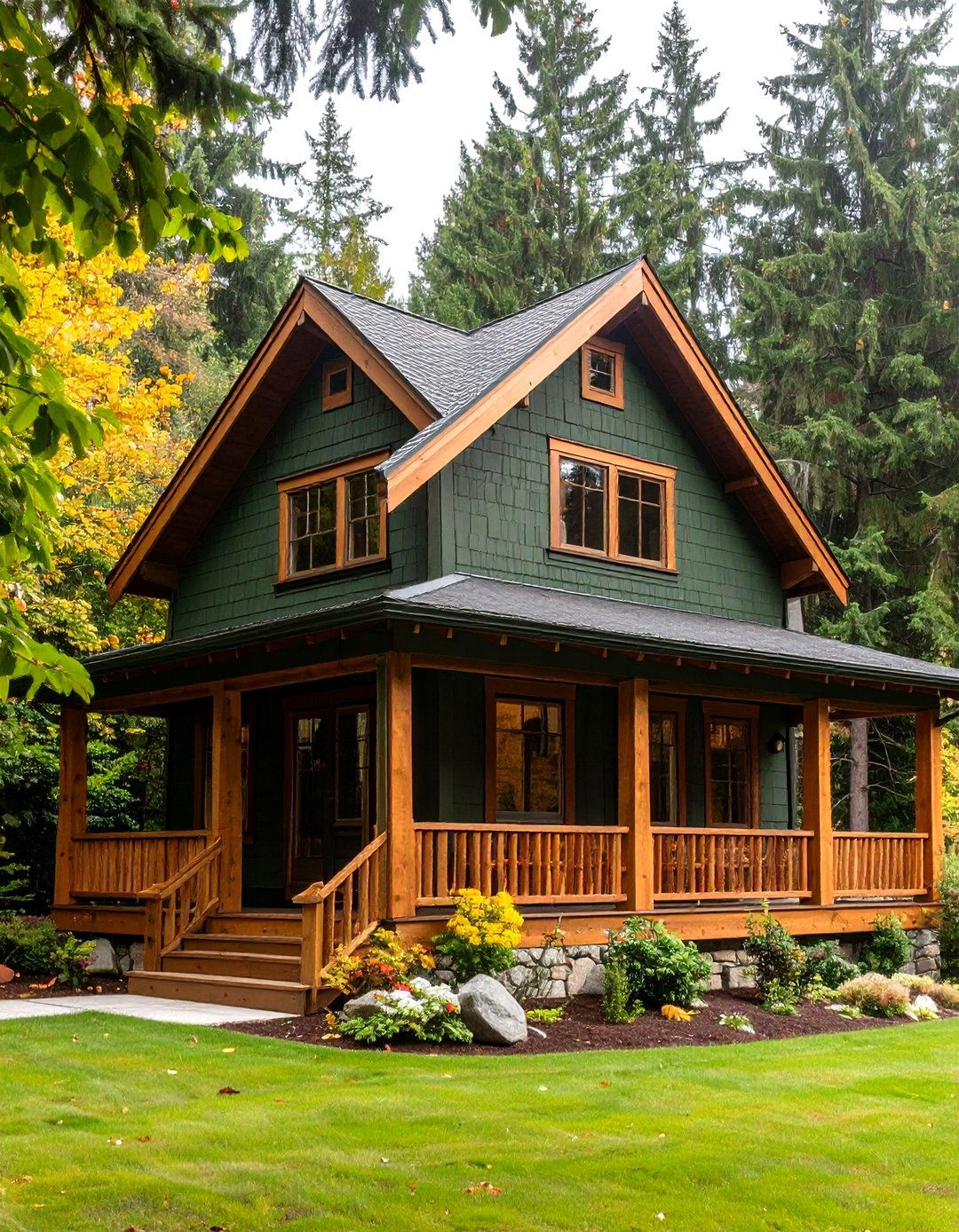
A Dark Olive Green House wrapped in horizontal cedar or thermally modified pine instantly feels connected to its setting. The soft brown-green hue lets the honey tones of natural wood porch posts, soffits and screens glow rather than compete, creating a layered, organic façade. To keep maintenance low, designers recommend factory-finished siding boards or durable fiber-cement panels pre-tinted to match the paint, then sealing exposed wood with a UV-blocking clear coat so it silvers gracefully over time. Add simple black sconces and a gravel apron at grade to reinforce the relaxed, cabin-in-the-woods atmosphere. Finally, repeat the wood on a slim mailbox post to echo the theme.
2. Dark Olive Green House Accented by Matte Black Trim
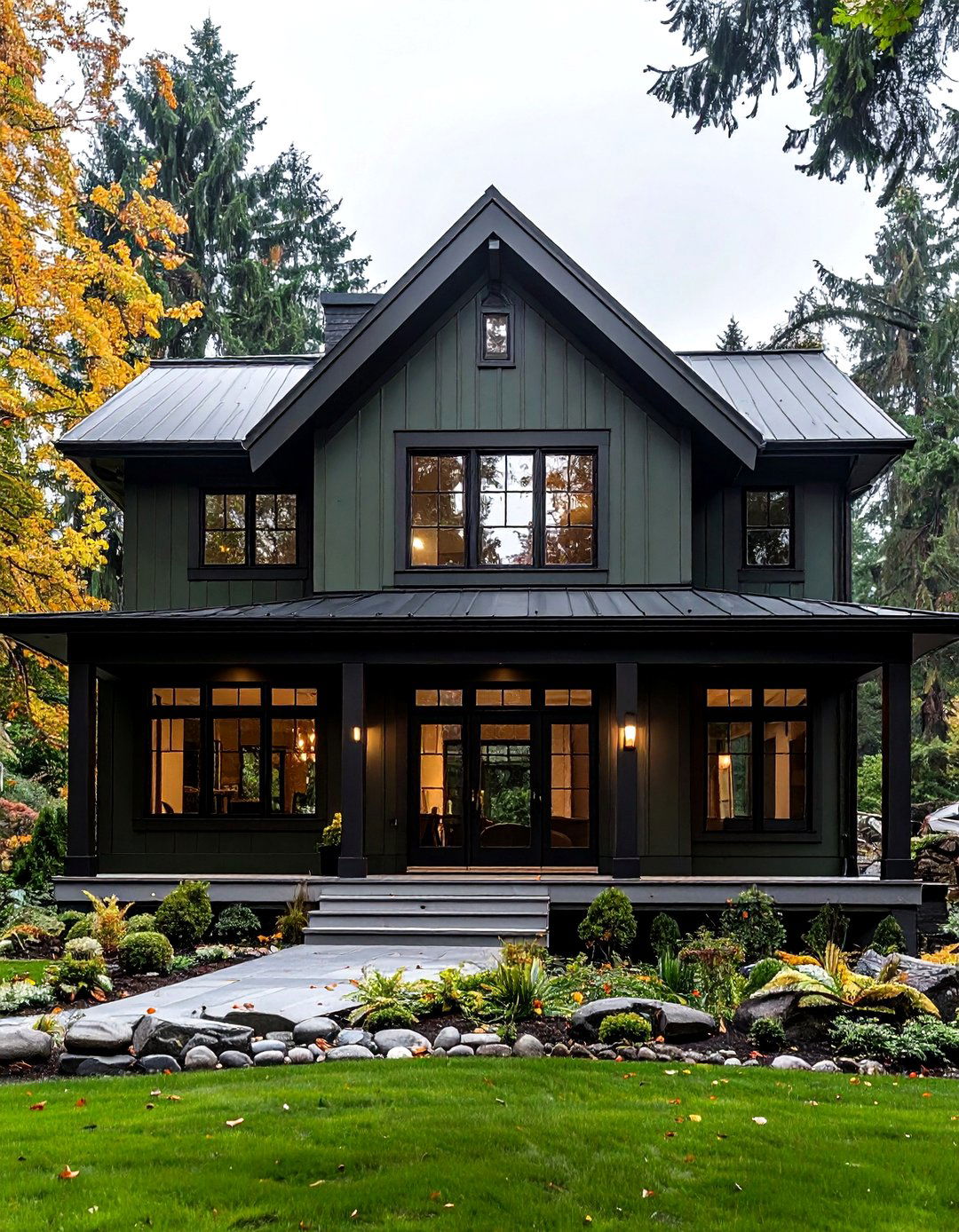
Unlike high-contrast white trim, a matte black frame makes a Dark Olive Green House look sharper and more contemporary without stealing focus from the colour itself. Choose powder-coated aluminum window casements and gutter guards in the same sheen so everything reads as one deliberate outline. Because the frames absorb light, they visually disappear at night, allowing accent lighting to highlight texture in the siding. Keep mullion patterns simple—two over two or single lite—to prevent busy grids. If you worry black will trap heat, specify thermally broken windows and low-E glazing to maintain interior comfort while keeping that bold silhouette intact.
3. Dark Olive Green House Highlighted with Copper Gutters
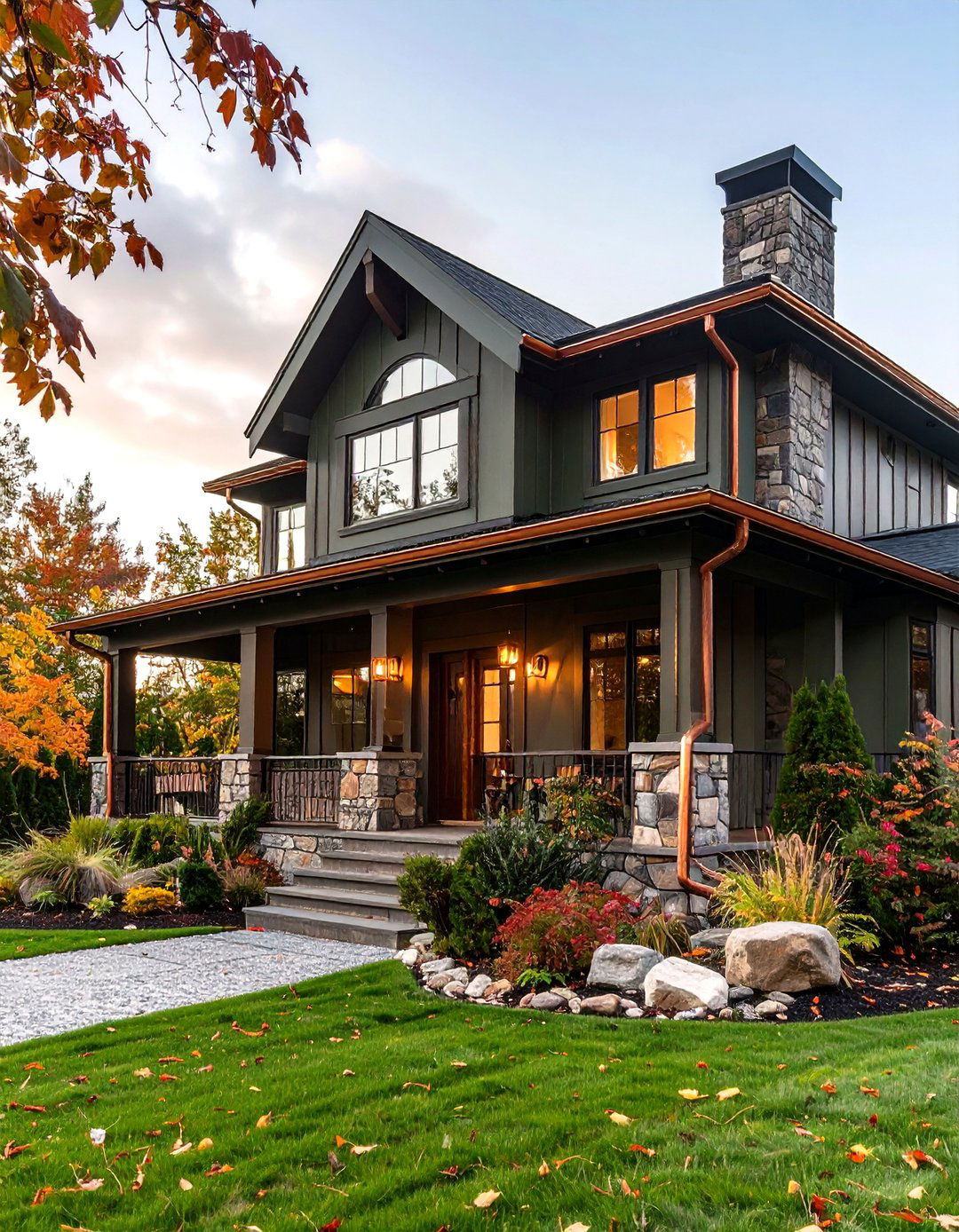
Take a Dark Olive Green House from tasteful to unforgettable by installing real copper gutters and downspouts that glow against the muted façade. Fresh copper’s rosy tone instantly reads artisanal, then weathers into a soft verde patina that complements the siding instead of clashing. For long-term performance, request soldered joints and 16-ounce copper, and add leaf screens to prevent tannin stains on the paint below. Because copper is self-healing, minor scratches oxidize quickly, making upkeep minimal. Finish the look with matching copper coach lights and a rain chain at the porch for a cohesive metal accent package that boosts curb appeal and resale value.
4. Dark Olive Green House Featuring Natural Stone Base
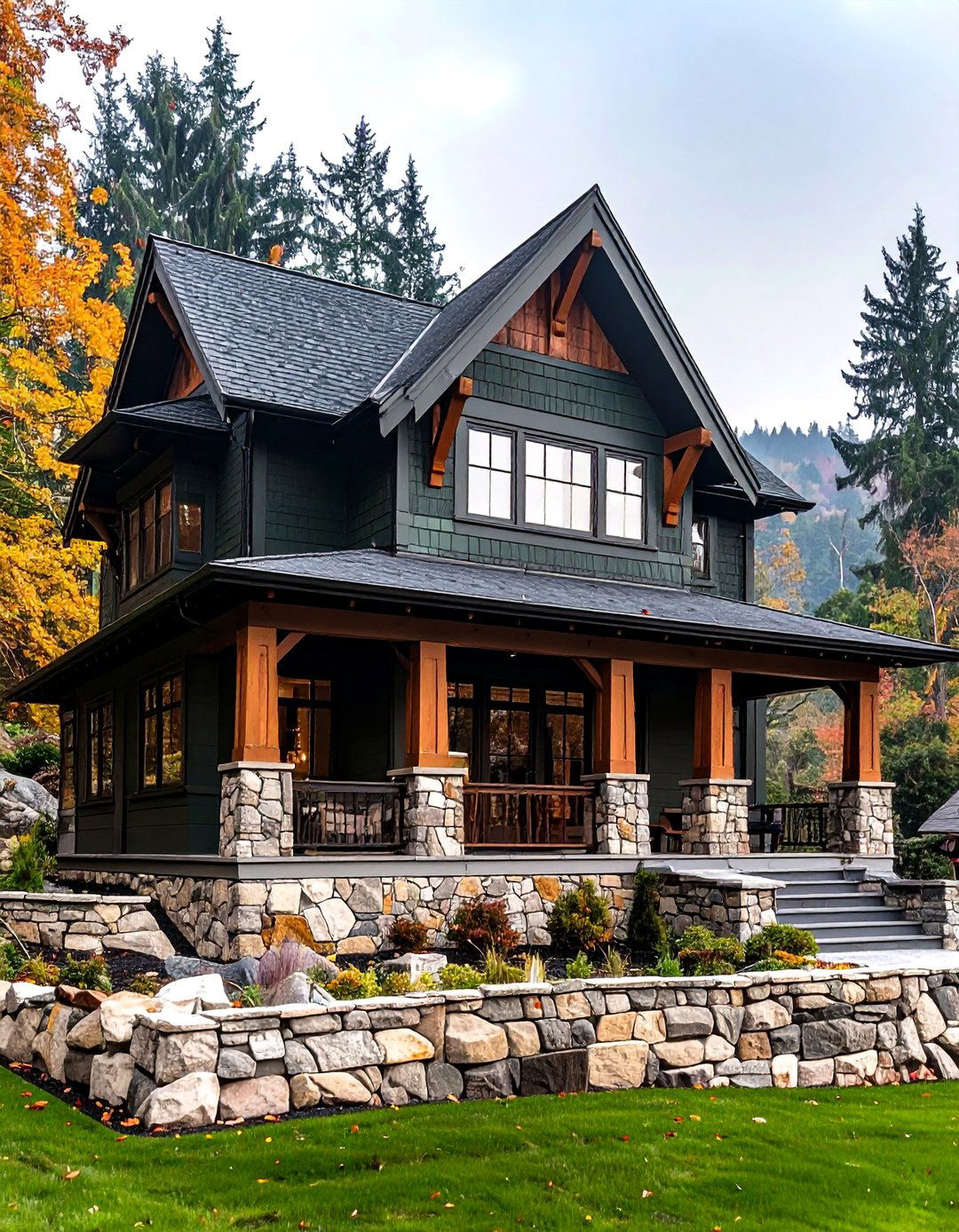
This design layers a hand-crafted Colonial tan stone skirt beneath lap siding to give a Dark Olive Green House instant gravitas and body. The buff stone warms the cool green, creates a durable drip edge, and visually anchors the structure to sloped lots. Keep the mortar slightly recessed to accentuate shadow lines and echo dimensional shakes above second-floor gables. Where budget allows, repeat the stone on vertical chimney chases or low garden walls for continuity. Pair with caramel-stained timber brackets and charcoal roofing so each material maintains its own register without competing, resulting in a timeless craftsman-inspired elevation that ages gracefully.
5. Compact Dark Olive Green House with White Shiplap Contrast
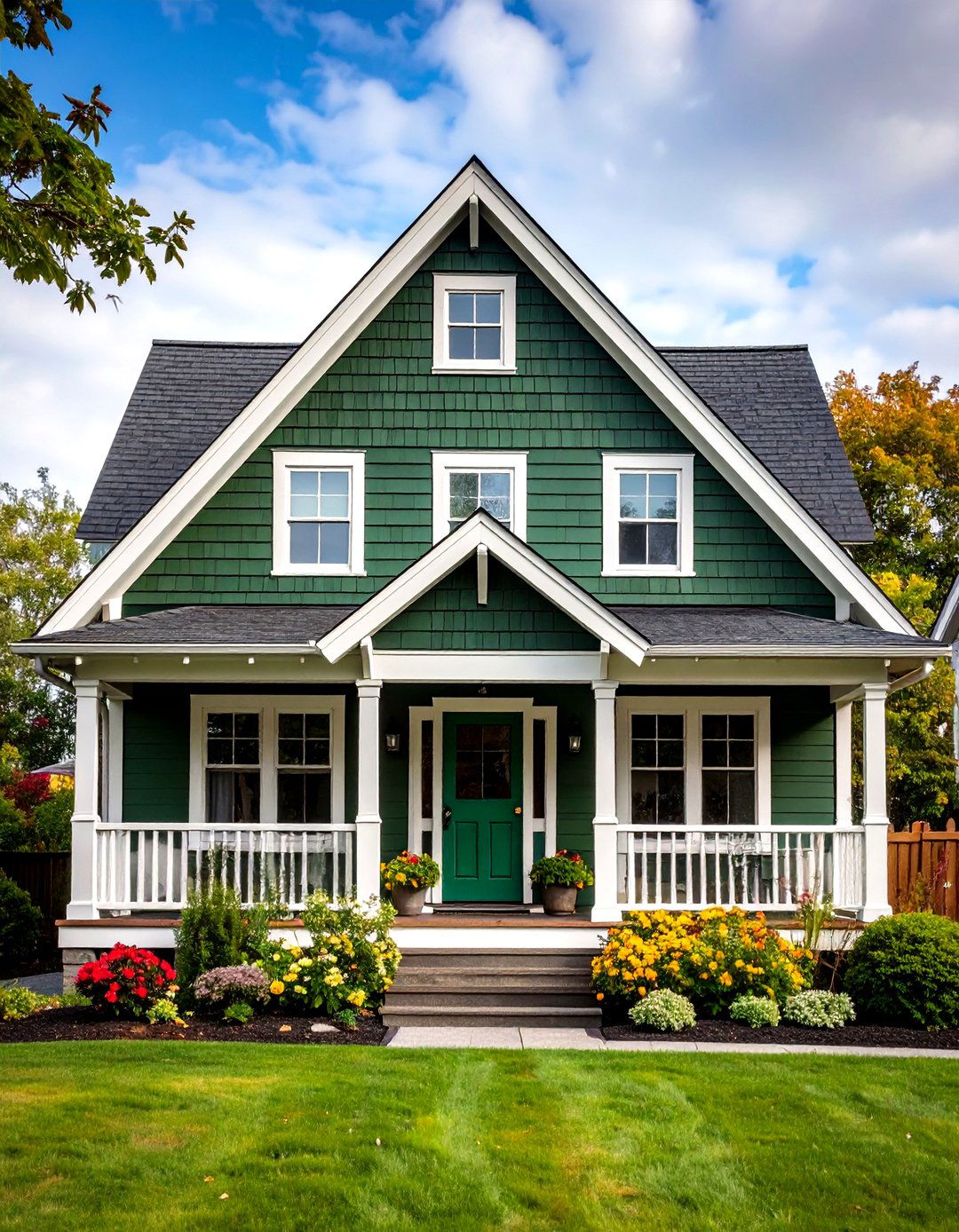
Looking to freshen a small cottage? Clad the gable ends in crisp white shiplap while keeping the body of the Dark Olive Green House intact for an uplifting yet budget-friendly remix. The high-value colour blocking draws the eye upward, making a single-story footprint appear taller and more balanced. Use PVC or engineered-wood boards with hidden fasteners so maintenance stays low. For cohesion, paint porch railings the same white, then echo the green on the front door to create a welcoming focal point. A narrow verge board painted charcoal helps transition between hues and prevents dirt streaks after heavy rains.
6. Modern Farmhouse Dark Olive Green House with Board-and-Batten
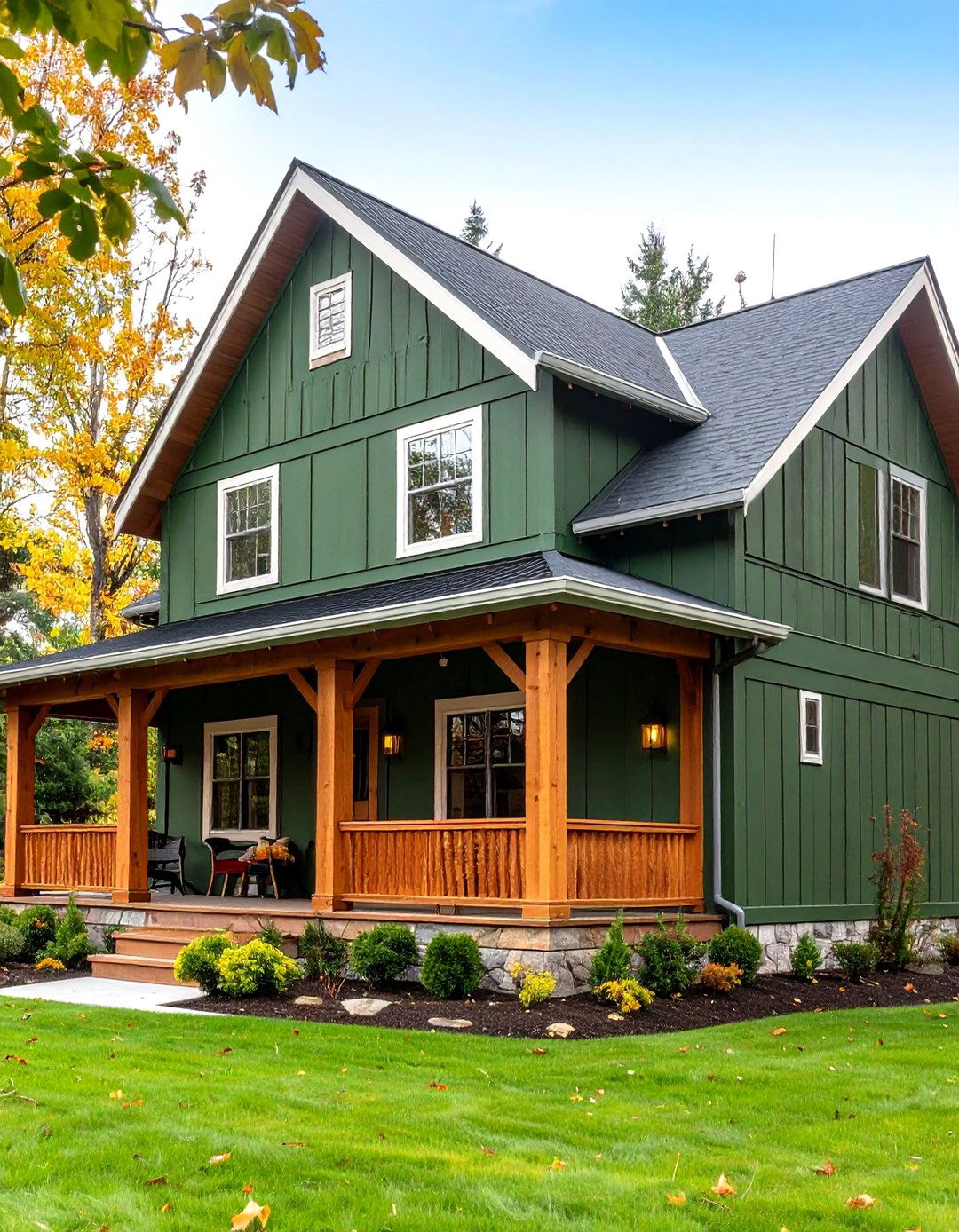
Board-and-batten siding lets a Dark Olive Green House channel modern-farmhouse charm without sliding into high-contrast clichés. The deep hue softens hard vertical lines, while the battens cast slim shadows that give the façade subtle movement throughout the day. Specify eight-inch fiber-cement panels primed on all sides to resist moisture, and run a mid-height trim band so you can switch to horizontal lap above for texture mix. Complete the agrarian nod with a standing-seam metal roof in matte charcoal and barn-style sconces. To prevent monotony, stain exposed porch beams warm walnut and plant clusters of grasses that sway against the vertical pattern.
7. Dark Olive Green House with Metal Roof Calm

Pairing a charcoal or matte bronze standing-seam roof with a Dark Olive Green House creates a low-maintenance envelope that shrugs off harsh weather and wildfire embers. The fine ribbing of metal contrasts the softer shingle texture, adding vertical emphasis without another colour. Insulate beneath the deck with a high-reflectance membrane to temper heat gain, and ask for factory-applied PVDF finish to resist fading. Because the roof is quieter than you might expect, simple clip-mounted snow guards or solar panels can be added later. A slim galvanized gutter profile keeps the roofline clean while still channeling water into rain barrels.
8. Sustainable Dark Olive Green House Using Recycled Siding
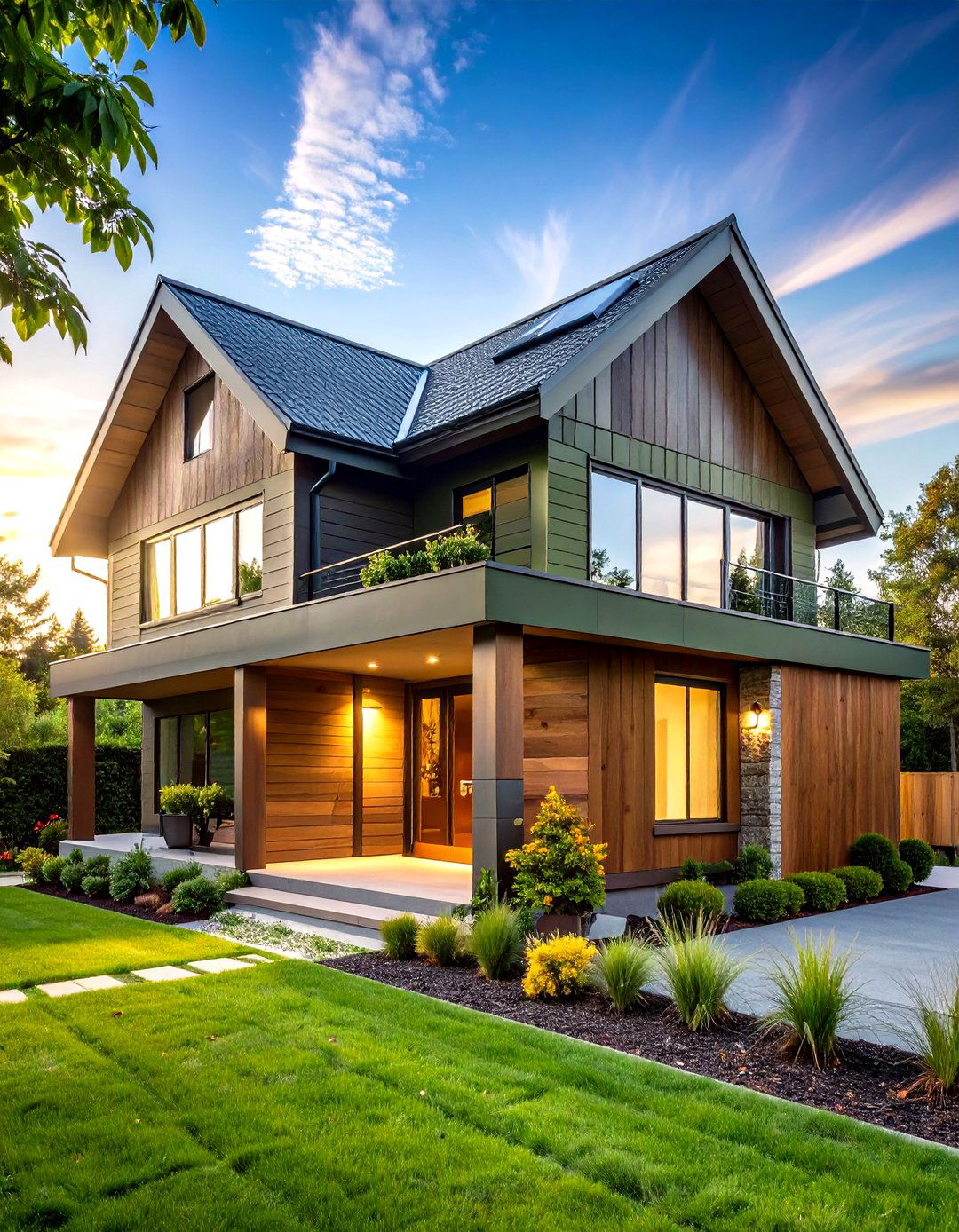
Homeowners seeking eco-credentials can specify recycled wood-fiber-cement boards pre-finished in olive green, turning their Dark Olive Green House into a low-VOC, fire-resistant shell that may last half a century with minimal repainting. Because the colour is baked on, fading is gradual and even, cutting future maintenance costs. Combine the siding with cellulose insulation and energy-recovery ventilation to lock in comfort while slashing HVAC loads. Where old vinyl is removed, recycle it through local take-back programs to divert landfill waste. Finally, choose screws over nails—future panels can be unscrewed and reused, keeping the project inside a circular-economy loop.
9. Dark Olive Green House Designed for Energy Savings in Cold Climates

In snowy regions, a Dark Olive Green House can work with the climate by absorbing a greater share of winter sun, helping interiors feel warmer without extra fuel. Studies on exterior paint show dark shades can take in up to 90 percent of solar energy, raising wall temperatures and easing heating demand. To maximize this passive gain, place larger windows on the south elevation and line the interior with a high-mass material such as brick veneer to store heat. A tight air-sealing strategy and insulated sheathing keep warmth from escaping, ensuring the darker palette is an asset rather than an energy penalty.
10. Dark Olive Green House with Wraparound Porch Charm
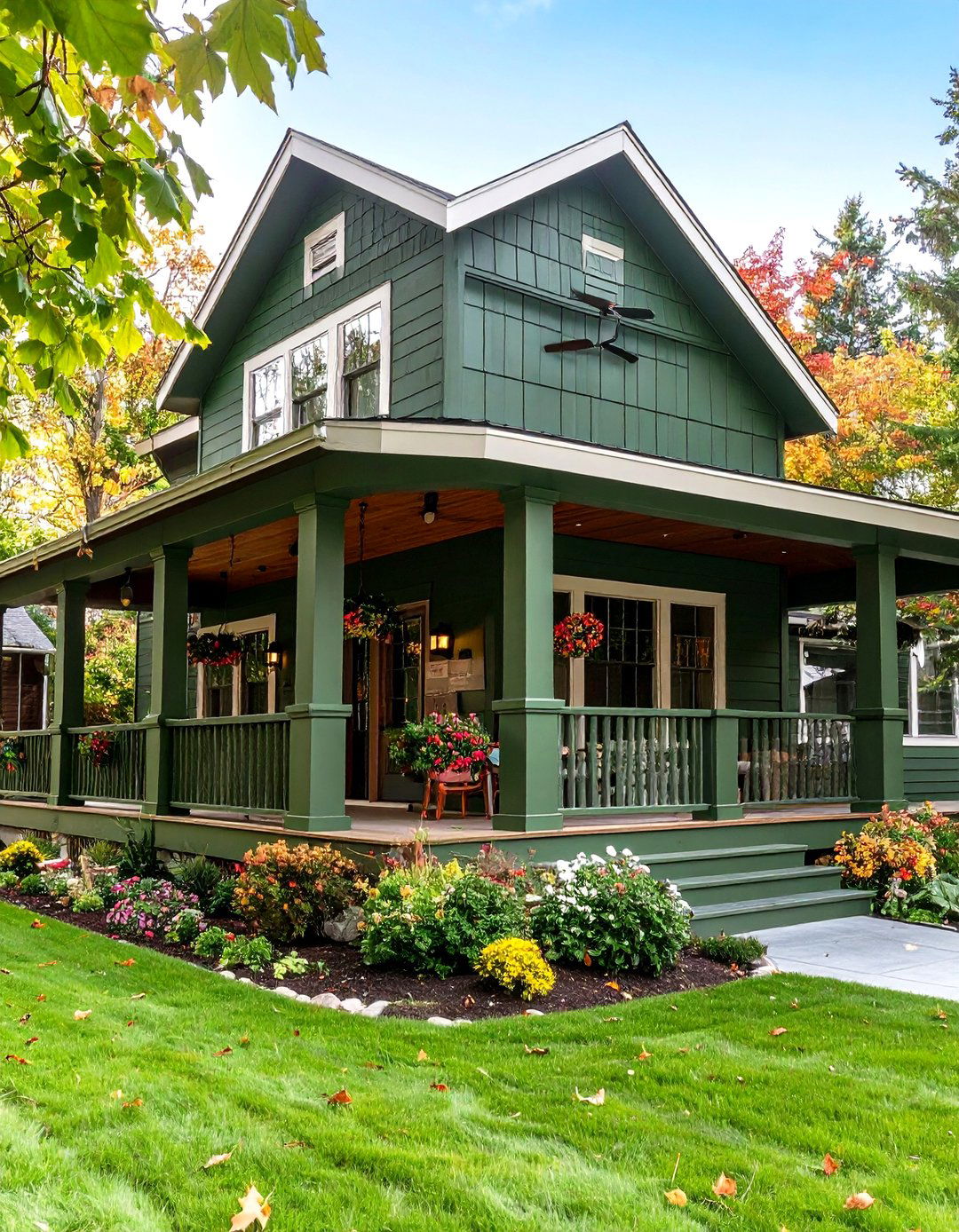
Few features sell a home faster than an inviting wraparound porch, and the muted tones of a Dark Olive Green House make any timber deck feel like an extension of the surrounding landscape. Plan for at least eight feet of depth so rocking chairs don’t block circulation, and anchor the railing system with chunky square newel posts painted in a slightly darker green for subtle depth. Tongue-and-groove pine ceilings stained a sandy tan reflect warm light onto the façade, while bronze ceiling fans keep summer air moving. Finish with dimmable sconces on motion sensors to highlight those generous porch eaves after dusk.
11. Dark Olive Green House Paired with Drought-Tolerant Landscaping
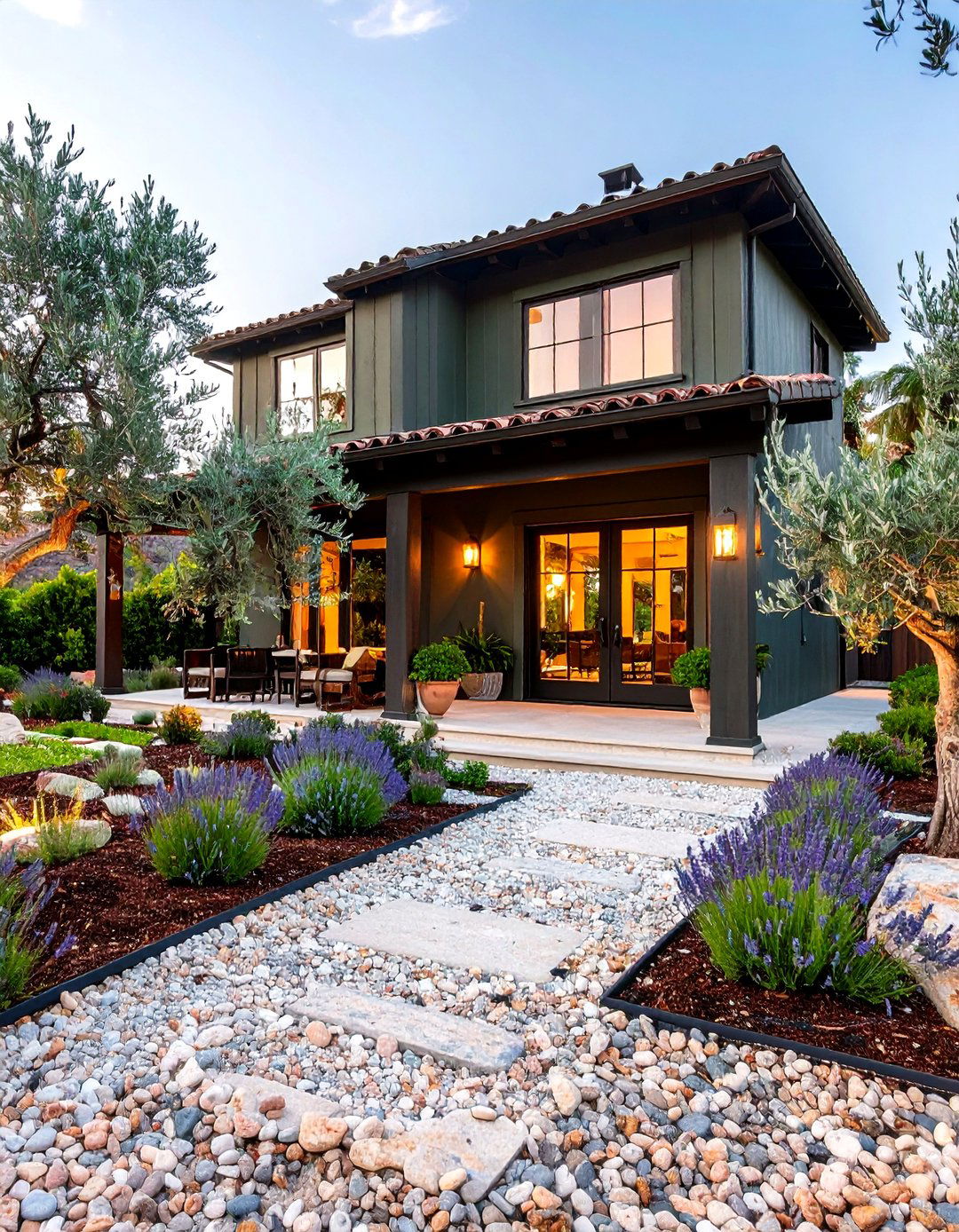
Landscape professionals advise echoing façade colours in the planting scheme, so pairing a Dark Olive Green House with silvery olive trees and swaths of lavender creates instant cohesion while slashing water use. Both plants thrive in lean soils and Mediterranean climates, requiring little more than annual pruning. Stagger three heights—dwarf olives near the porch, full standards as corner anchors, and low mounds of ‘Elijah Blue’ fescue between—to create depth without clutter. A three-inch gravel mulch keeps soil temps stable and ties visually to stone paths. Run drip irrigation beneath the mulch, then top-dress beds yearly with compost for stress-free greenery.
12. Dark Olive Green House with Large Black-Framed Windows
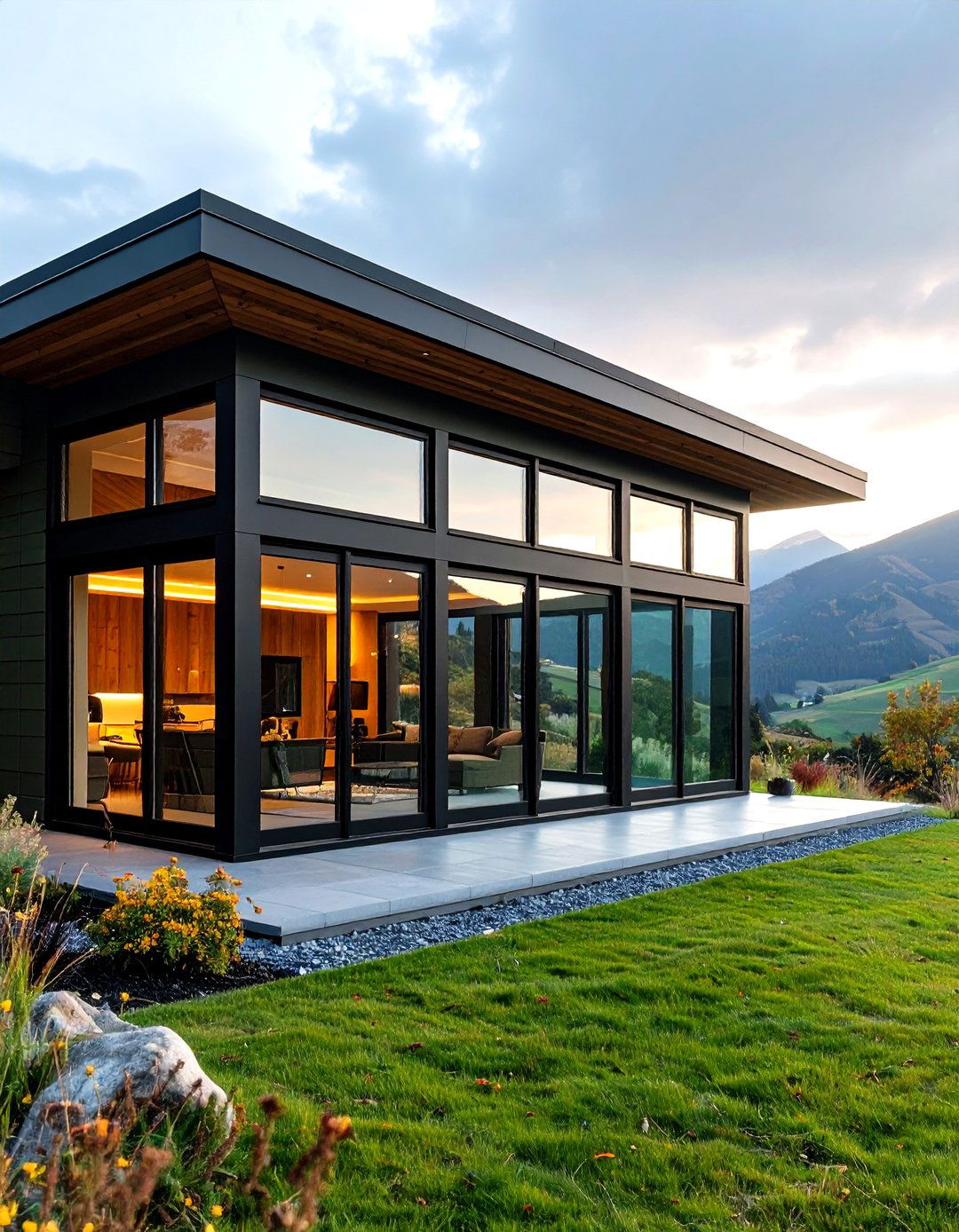
Designers use oversized picture windows to blur interior-exterior boundaries, and a Dark Olive Green House provides the perfect low-glare backdrop for deep black frames. Dark sashes act like camera borders, sharpening outdoor vistas and hiding dirt better than white alternatives. Opt for narrow-profile thermally broken aluminum to keep sightlines clean; a 2:1 height-to-width ratio generally feels harmonious on traditional façades. Install concealed roll-down insect screens in the header so views remain uninterrupted. Inside, paint the drywall returns the same black to enhance the tunnel effect, then layer linen Romans for softness. A low-sheen finish prevents the frames from reading plastic under bright sun.
13. Dark Olive Green House Enhanced by Brass Hardware Accents

Subtle brass details—door handles, house numbers and lighting canopies—inject quiet luxury into a Dark Olive Green House without overwhelming its earthy palette. Satin or antique-brass finishes stand out just enough against the green, aging gracefully as they acquire a warm patina. For consistency, specify the same alloy family on porch lanterns and mailbox flags; many manufacturers offer coastal-grade lacquer to resist tarnish in humid zones. Backing plates in matte black keep reflections controlled, while warm-white LED bulbs maintain the metal’s golden hue at night. A wide brass kickplate protects the door and echoes the hardware’s understated sheen.
14. Dark Olive Green House With Mixed Textures of Shake and Lap

Texture mixing prevents large façades from feeling flat, and a Dark Olive Green House excels at this thanks to the colour’s subtle shadow play. Use staggered cedar shakes in gables for cottage romance while keeping smooth lap siding on lower stories for easy cleaning. A five-inch reveal on lap boards feels modern, whereas taper-sawn shakes deliver organic variance above. Separate the two with a simple drip-cap trim painted slightly darker to minimize visual clutter. Accent rafters in ebony stain to echo window mullions, and sprinkle bronze down-lights to graze the shake surface, revealing its lively grain after sunset.
15. Coastal Dark Olive Green House with Sage Doors

Along salty shorelines, deep greens reduce glare from bright sand while resisting bleaching. Paint the body dark olive and specify a lighter sage on doors to give a Coastal Dark Olive Green House a relaxed, nautical nod without navy-and-white clichés. Satin-nickel hinges withstand corrosion, and composite decking resists swelling from humidity. Break the massing with horizontal cable rail that echoes maritime lines while preserving ocean views. Because sea breezes carry abrasive salt, rinse the façade twice a year with low-pressure fresh water and inspect door seals to keep that calming palette crisp through many sun-soaked seasons.
16. Dark Olive Green House with Dramatic Gables and Uplighting

Pointed gables painted in dark olive are naturally moody; adding low-wattage uplights at the eaves turns a Dark Olive Green House into evening sculpture. Position LED fixtures two feet off the wall and aim them slightly outward to avoid hot spots while grazing the siding’s texture. Warm 2700-Kelvin lamps complement copper gutters and brass hardware, creating a cohesive nighttime palette. Ensure wiring is concealed behind shrubbery or routed through conduit painted to match the wall. Install a photocell timer so lights engage at dusk and shut off before sunrise, balancing ambiance with energy savings for subtly theatrical curb appeal.
17. Dark Olive Green House with Scandinavian Minimalist Lines
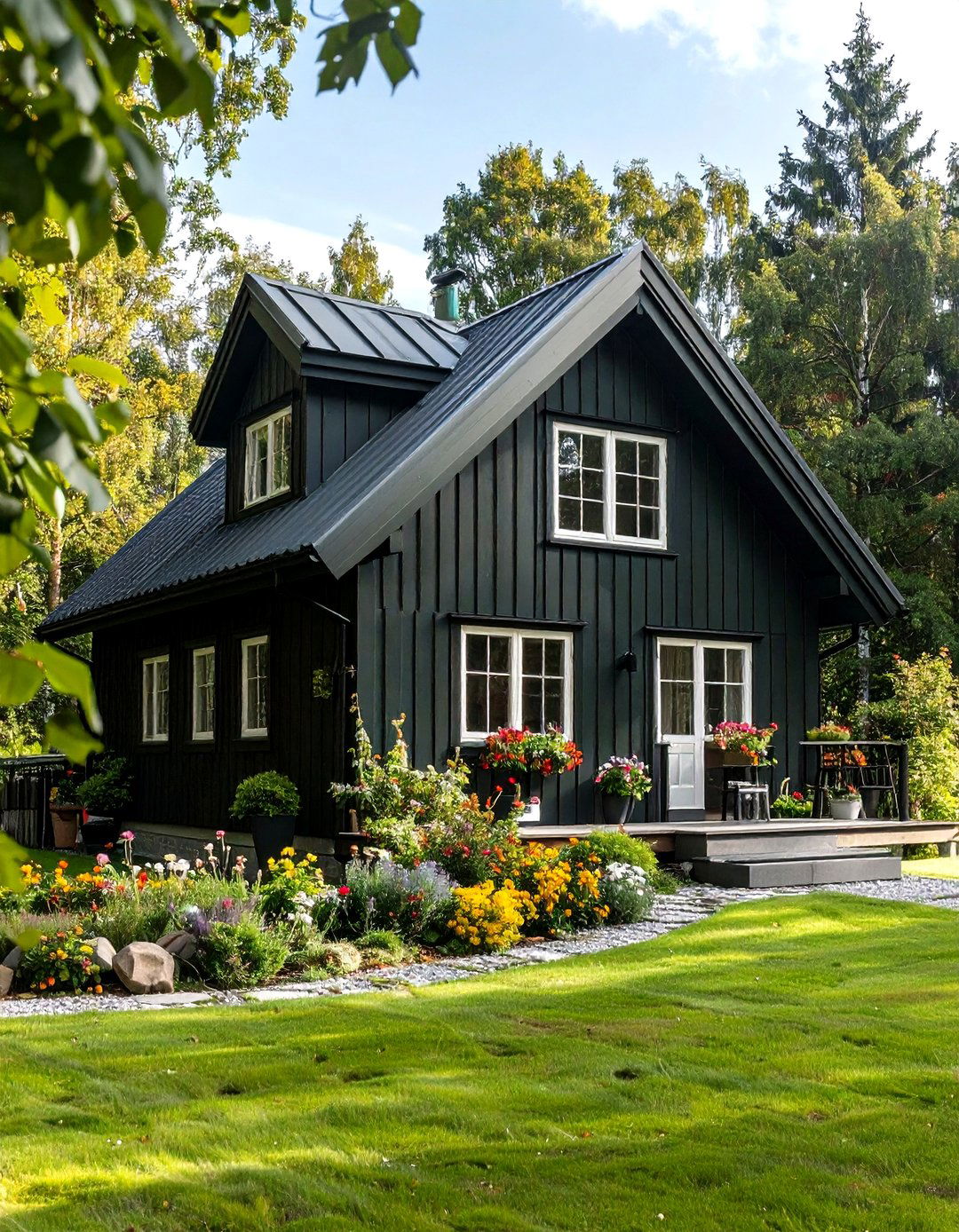
Scandinavian exteriors celebrate restraint, so give a Dark Olive Green House pared-back profiles: flush eaves, flat fascia and a single, unbroken siding material. The muted green acts as a sophisticated neutral that offsets low winter light better than stark white. Choose vertical tongue-and-groove cladding for subtle shadow and pair with triple-pane windows for thermal performance. Keep hardware minimal—slim bar pulls and recessed downlights—and forgo shutters altogether. Gravel terraces edged in corten steel create textural contrast without excess colour, while an open grid of birch trees softens hard lines, delivering the calm, hygge-ready ambiance synonymous with Nordic design today.
18. Dark Olive Green House Restoring a Craftsman Bungalow

Restoring a 1910s bungalow? Historically accurate hues hover in the mid-green family, so a Dark Olive Green House fits the Craftsman palette while allowing updated materials beneath. Preserve original tapered columns and knee-braces, repainting them warm cream to mirror vintage colour blocking. Replace brittle cedar shingles with fiber-cement look-alikes to boost fire resistance yet keep historic texture. Stain porch ceilings light fir and swap rusted hardware for oil-rubbed bronze that matches aged roof vents. Finally, invest in period-appropriate art-glass sconces—they bounce amber light across the olive boards, evoking the cozy glow that defined early twentieth-century streetscapes today.
19. Dark Olive Green House with Indoor-Outdoor Flow
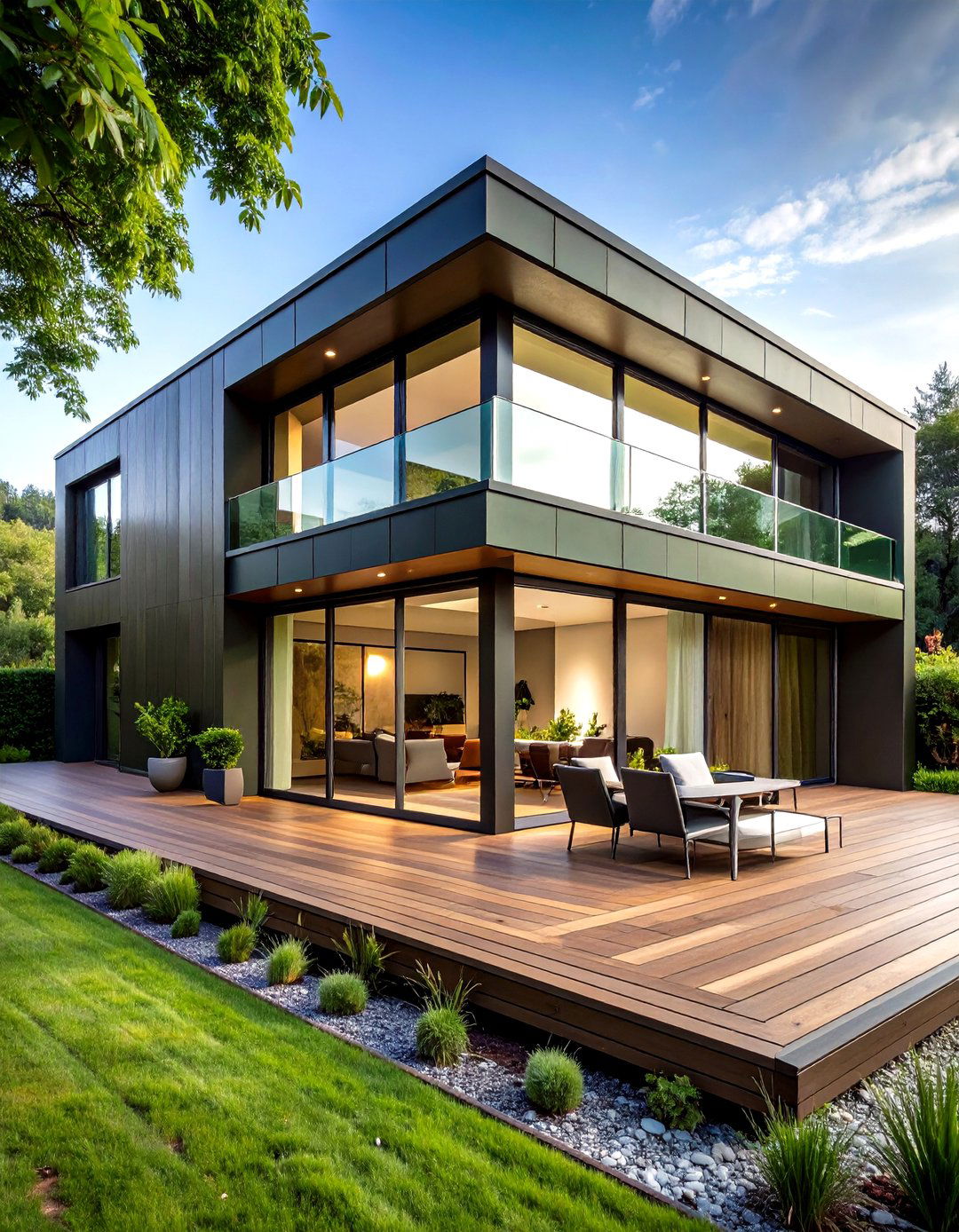
Sliding glass walls and flush thresholds turn a Dark Olive Green House into a year-round pavilion, echoing lifestyle shifts highlighted in current outdoor trend studies. Stain deck boards to match interior hardwood tones, creating a continuous visual plank. Specify pocketing doors on oversize rollers to glide smoothly despite seasonal expansion, and flank the opening with outdoor draperies for privacy on demand. To prevent heat loss, integrate heated slab edges beneath the sill and seal tracks with brush gaskets. Outside, extend the roof overhang an extra eighteen inches so furnishings remain dry, making the transition seamless even when weather shifts suddenly.
20. Dark Olive Green House with Solar Panels and Green Roof
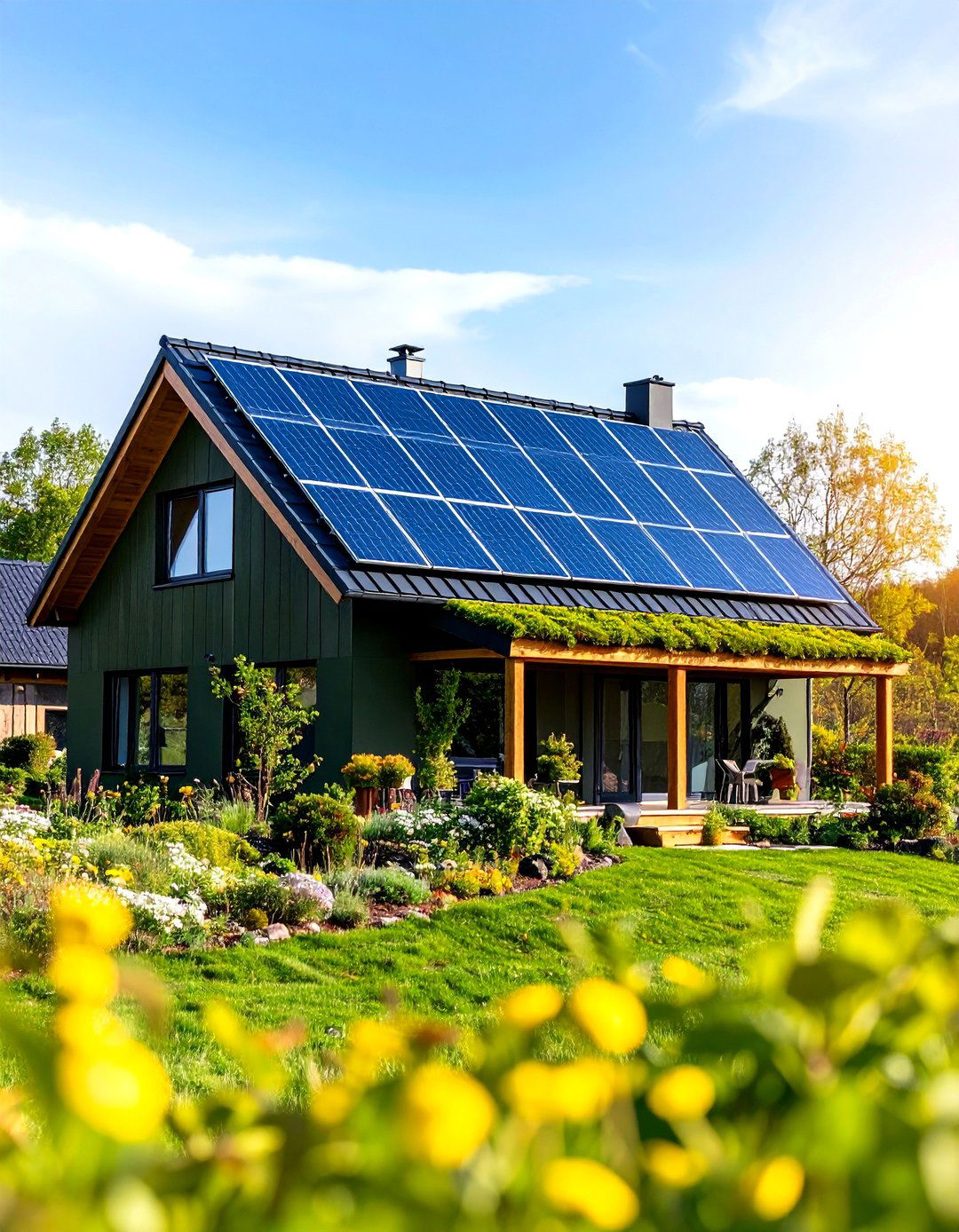
Those craving self-sufficiency can pair photovoltaic arrays with a sedum-topped porch roof, turning a Dark Olive Green House into a quiet net-zero powerhouse. Matte-black panels virtually disappear against the deep siding, especially when aligned with roof seams for an architecturally integrated look. Under the array, a modular green roof keeps ambient temperatures low, boosting solar efficiency by as much as five percent in peak heat. Choose drought-tolerant sedum mixes and lightweight substrate to avoid overloading rafters. Wire in a battery backup for nighttime loads, and display real-time production on a foyer tablet so sustainable performance becomes part of daily life.
Conclusion:
From rustic stone skirts to solar-ready roofs, dark olive green proves remarkably adaptable, harmonizing with nearly every material and climate. Designers applaud the hue’s ability to add depth without the somberness of black, its maintenance-friendly camouflage of dust and pollen, and its surprising energy advantages in colder zones. When paired thoughtfully with trim, lighting and landscaping, a Dark Olive Green House can read modern, coastal, craftsman or minimalist while staying rooted in nature’s palette. Balance texture, proportion and light so the colour feels intentional, not trendy. Do that, and this timeless shade will reward you with enduring curb appeal and daily moments of calm.


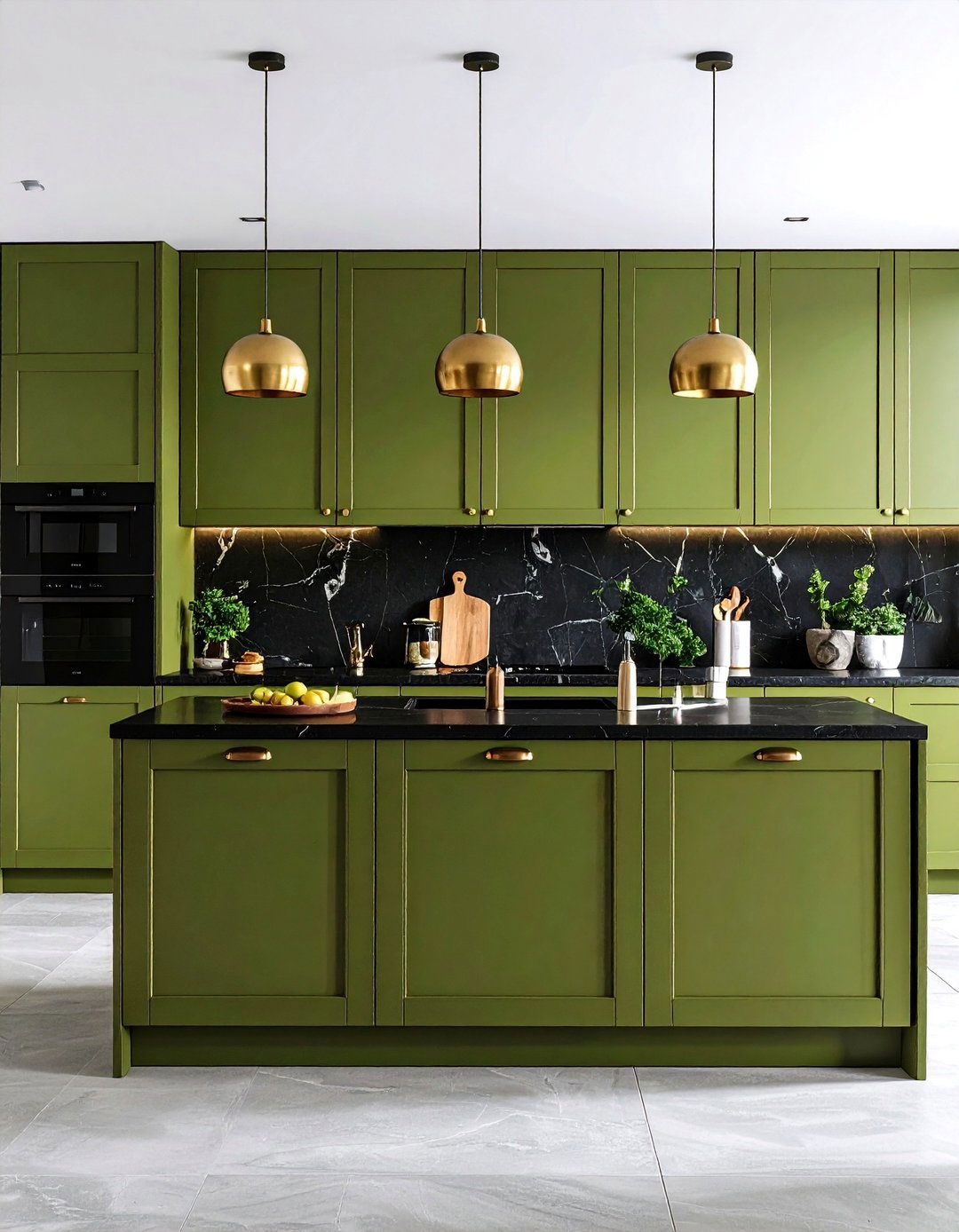
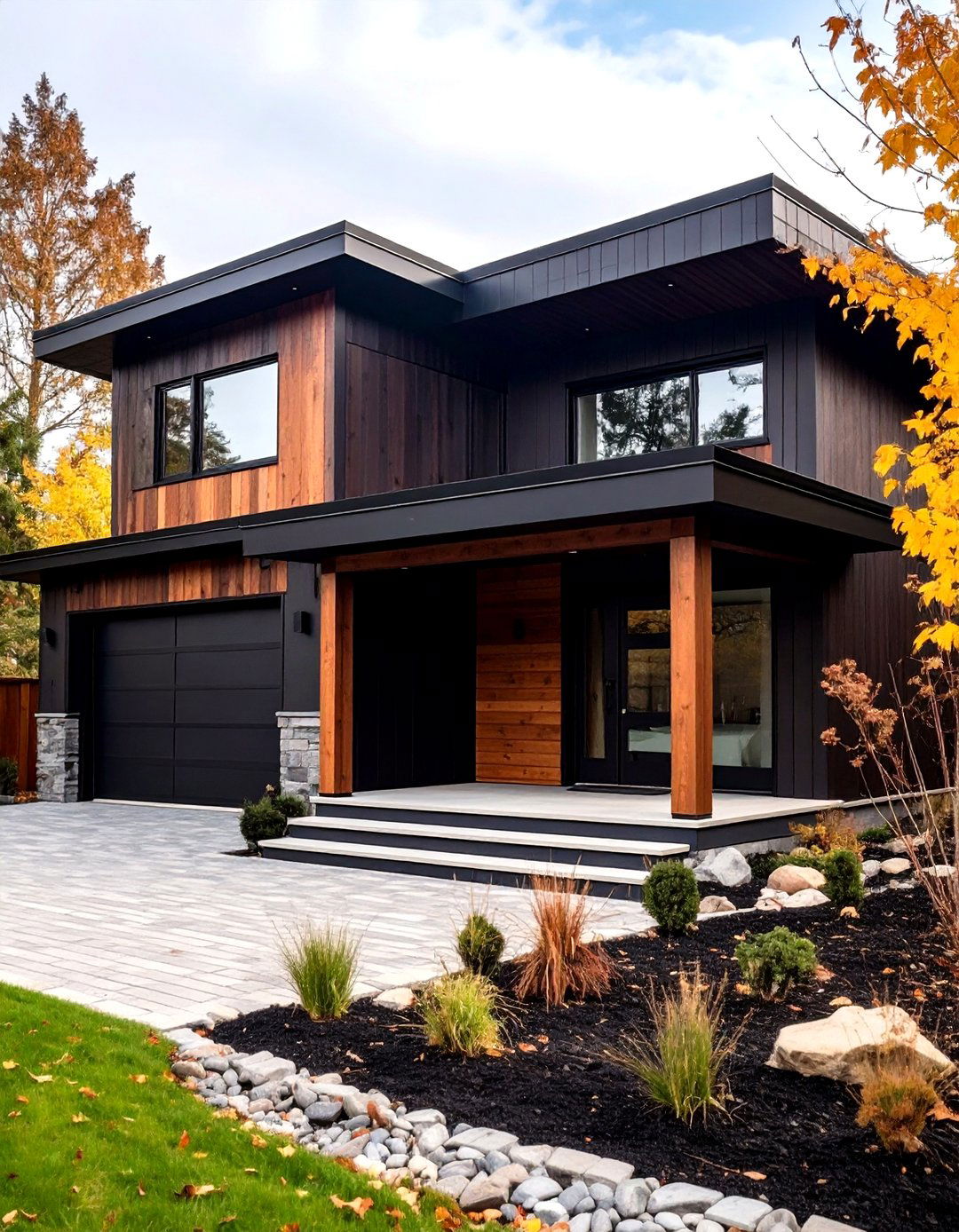
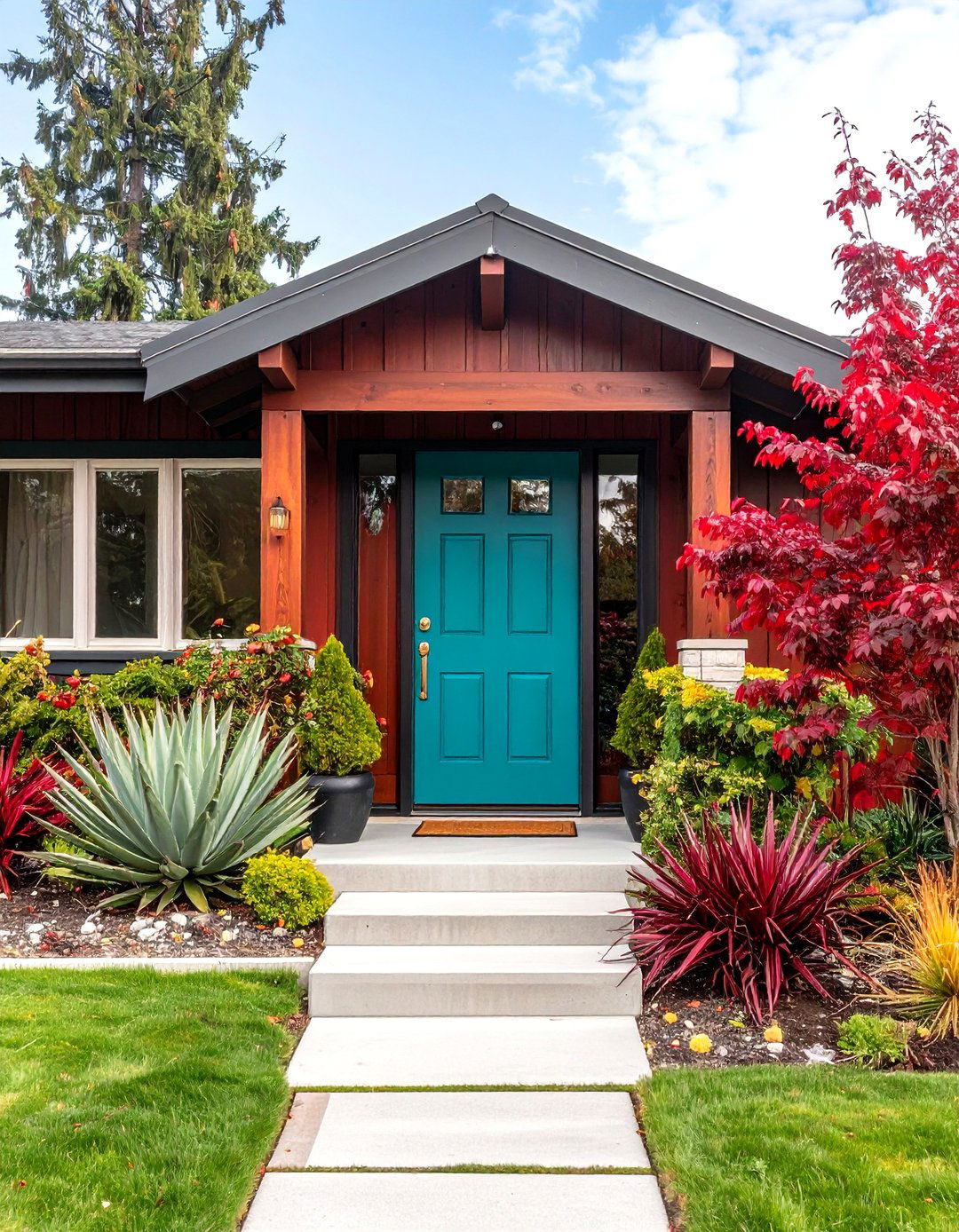
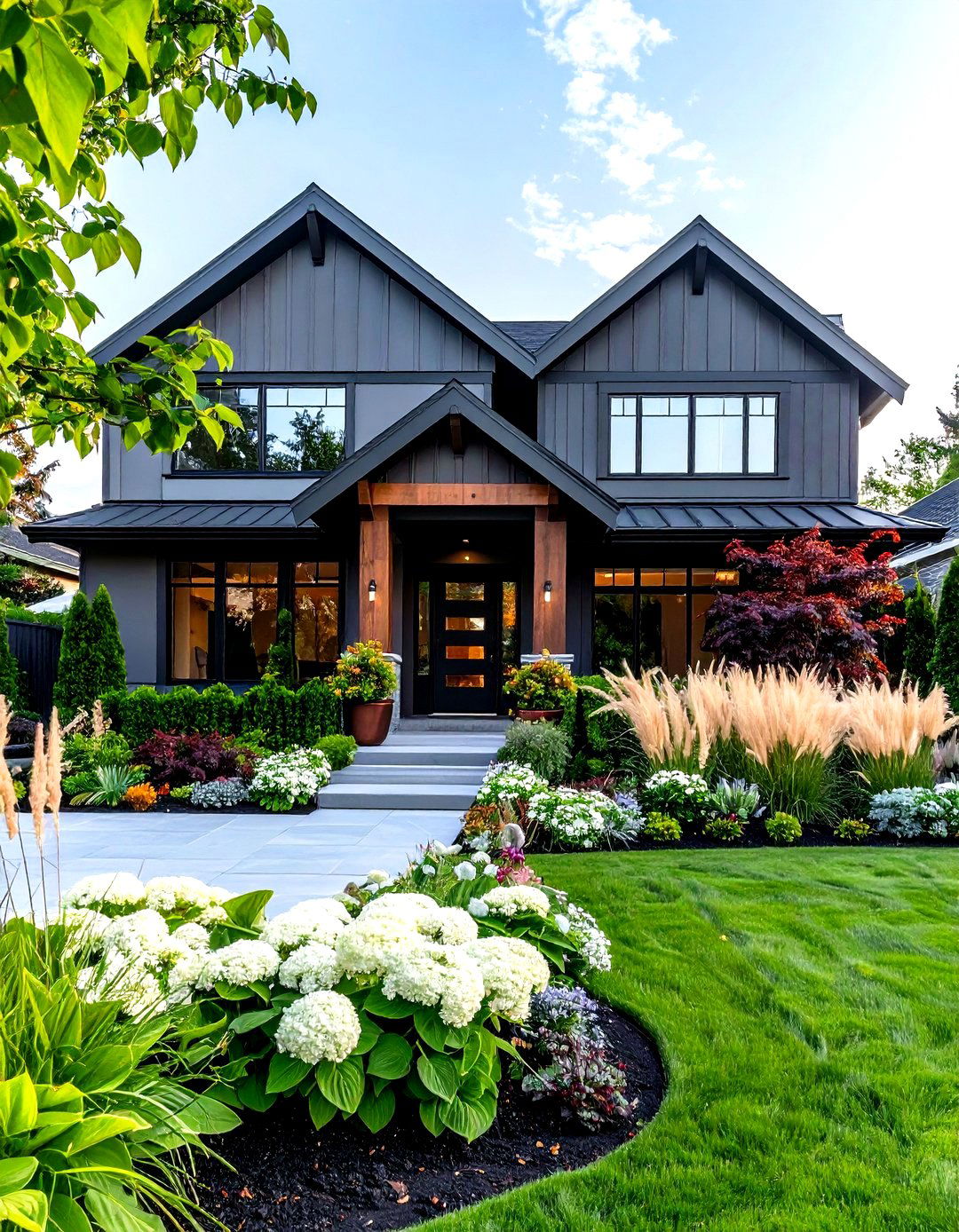
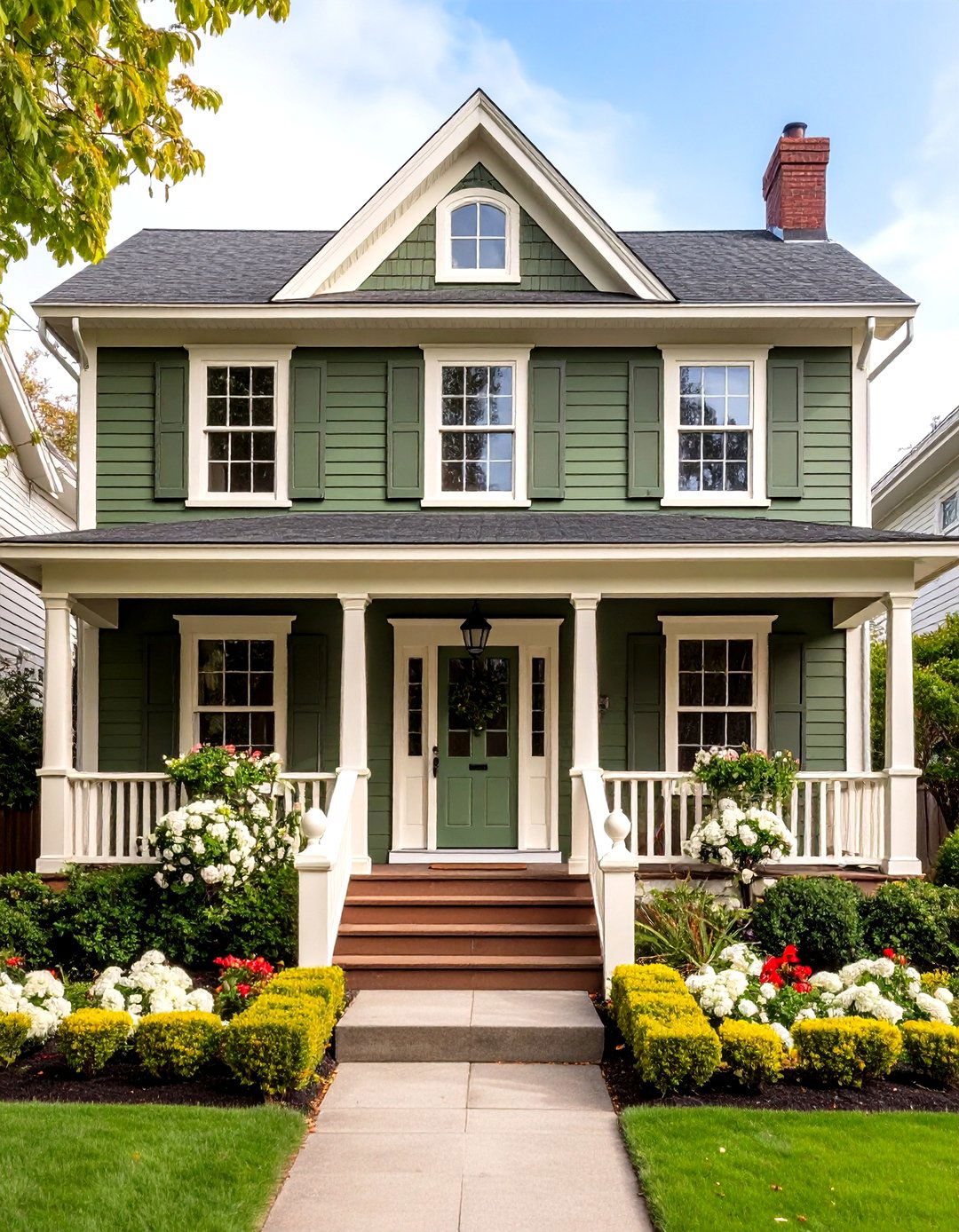
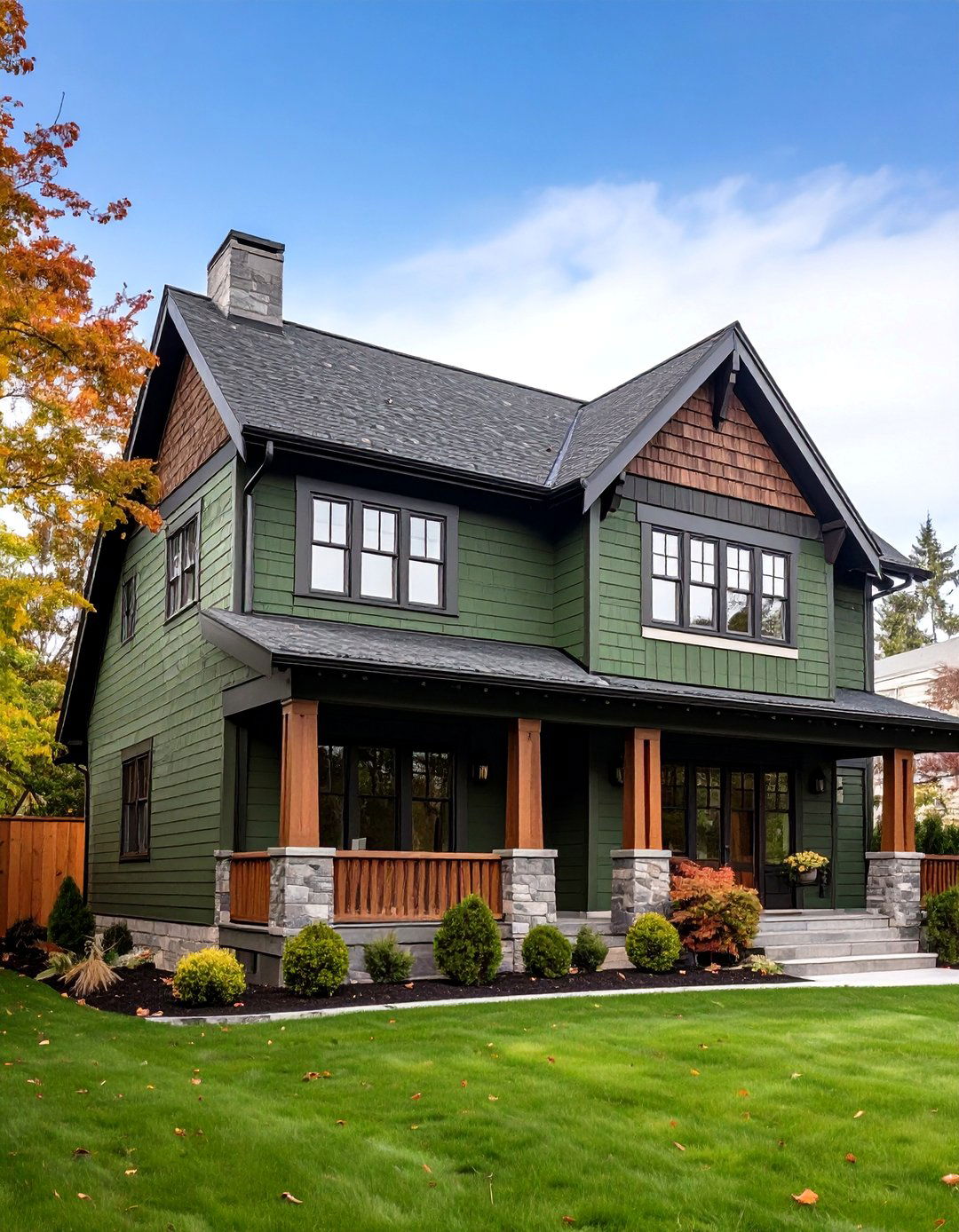
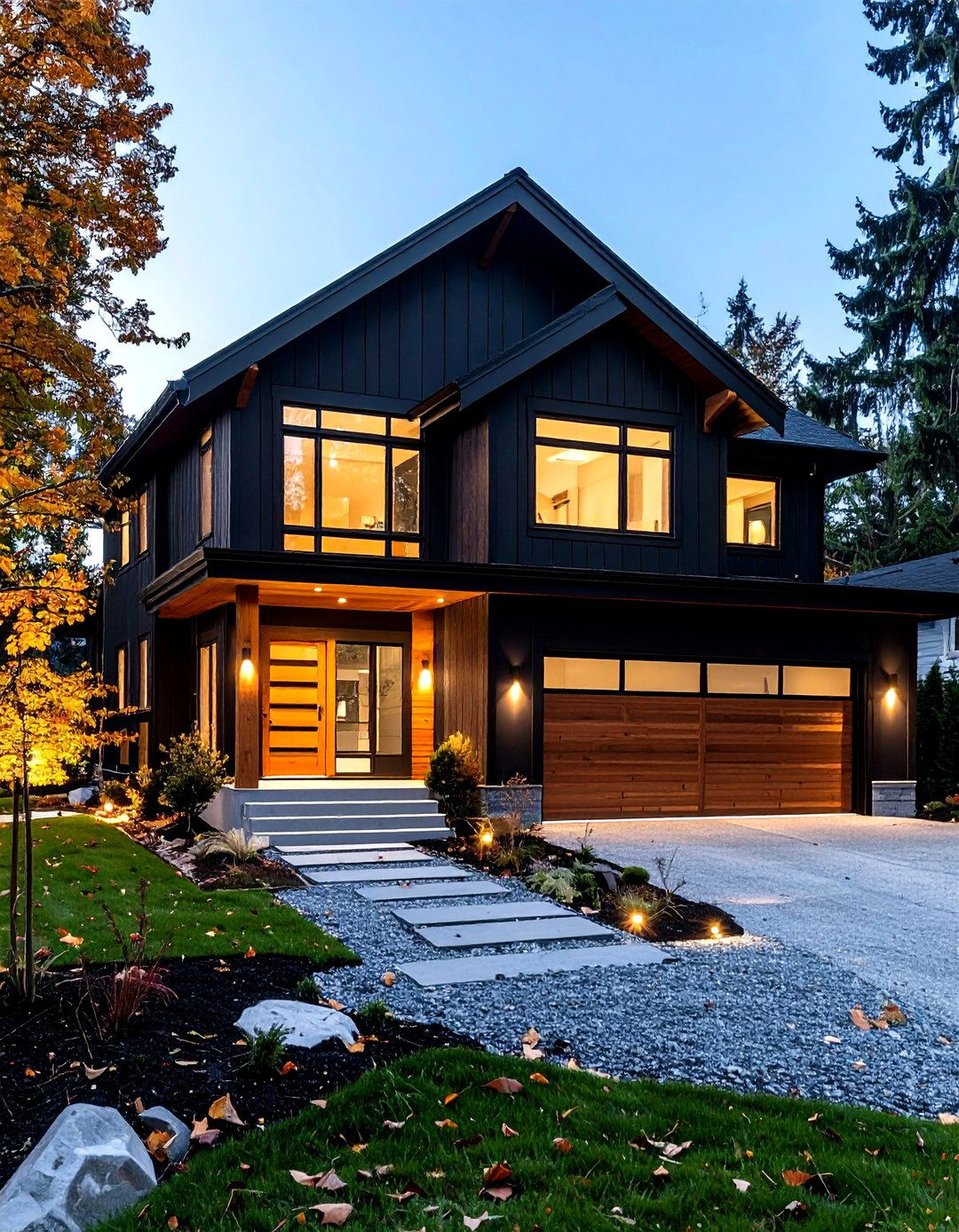
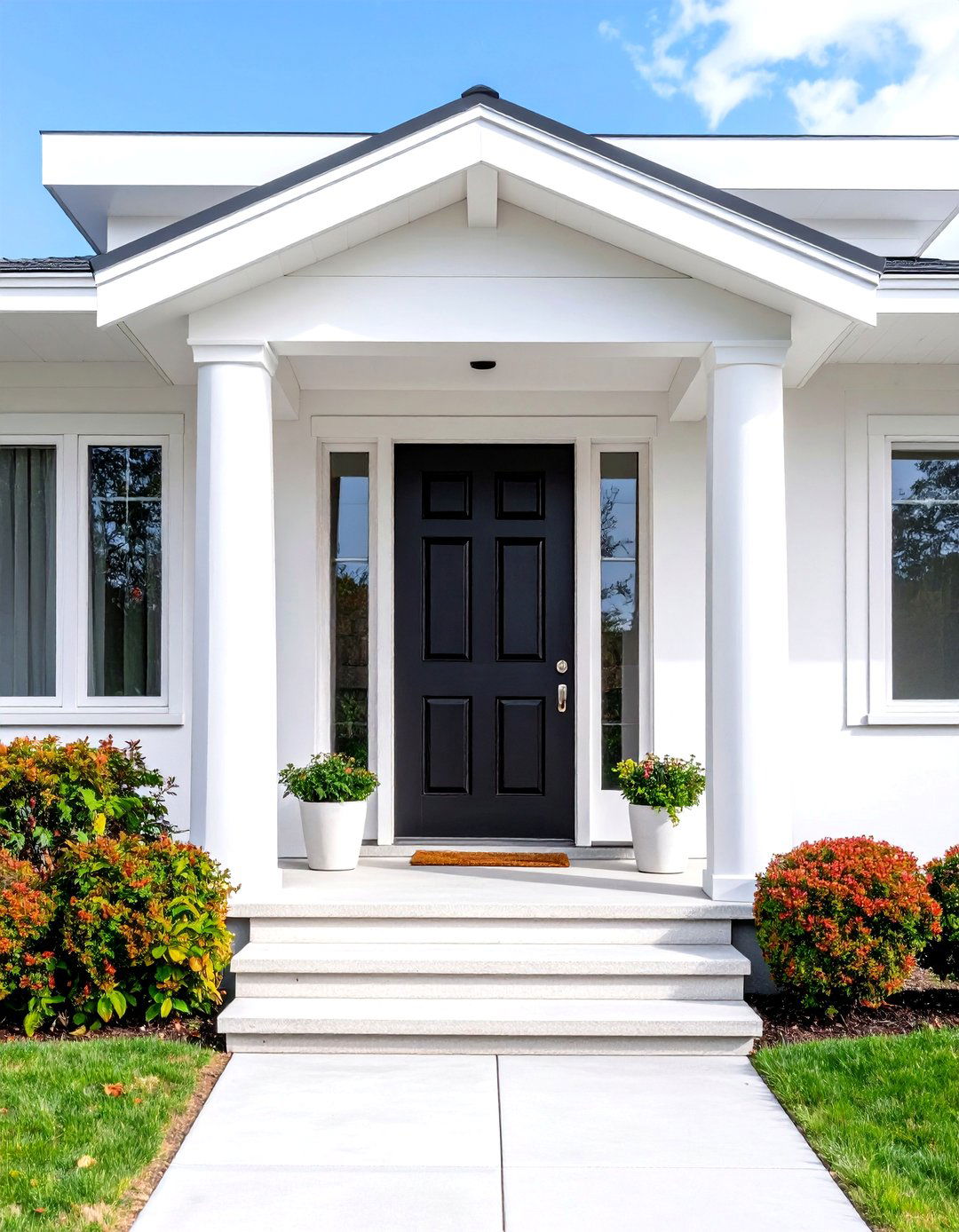
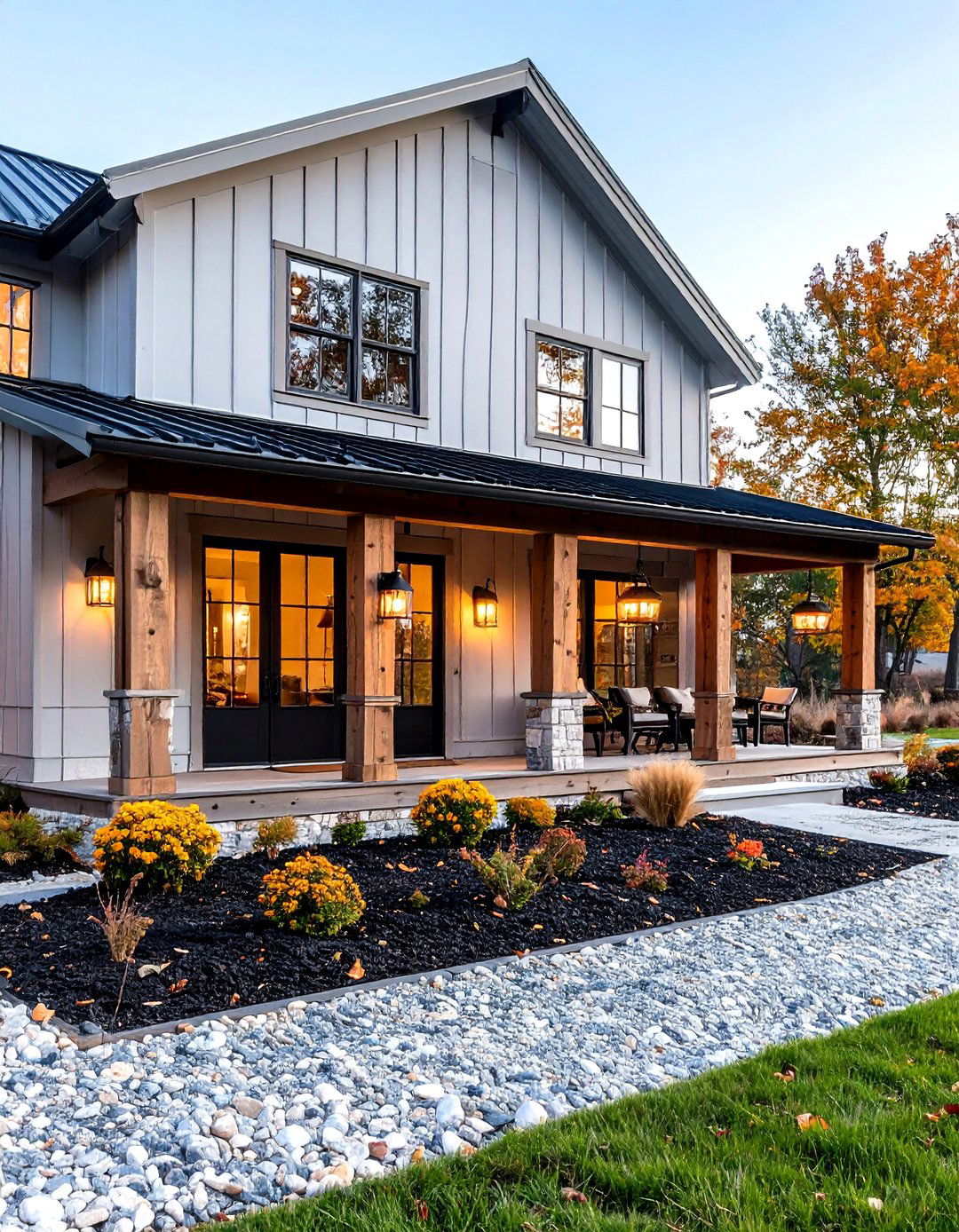
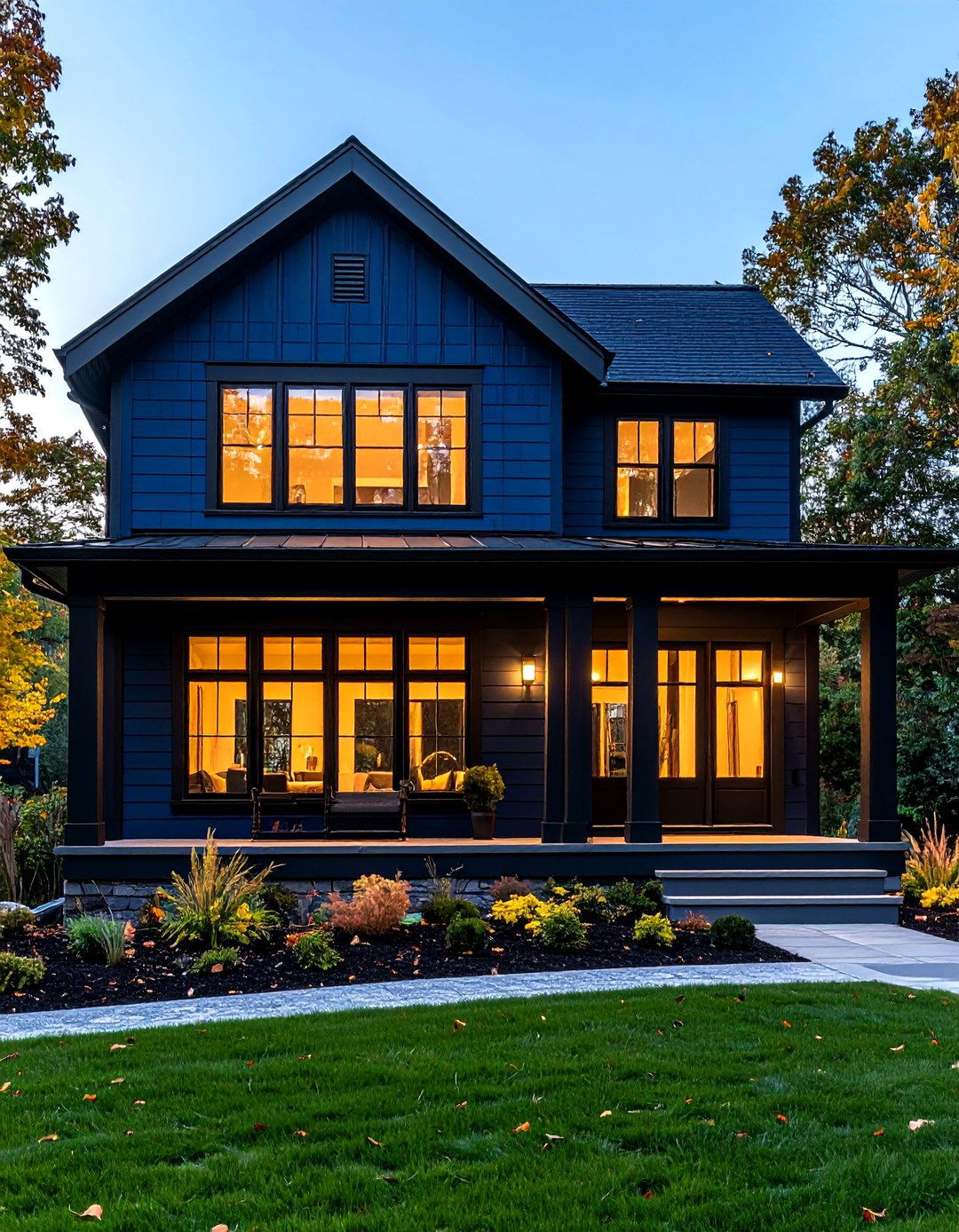

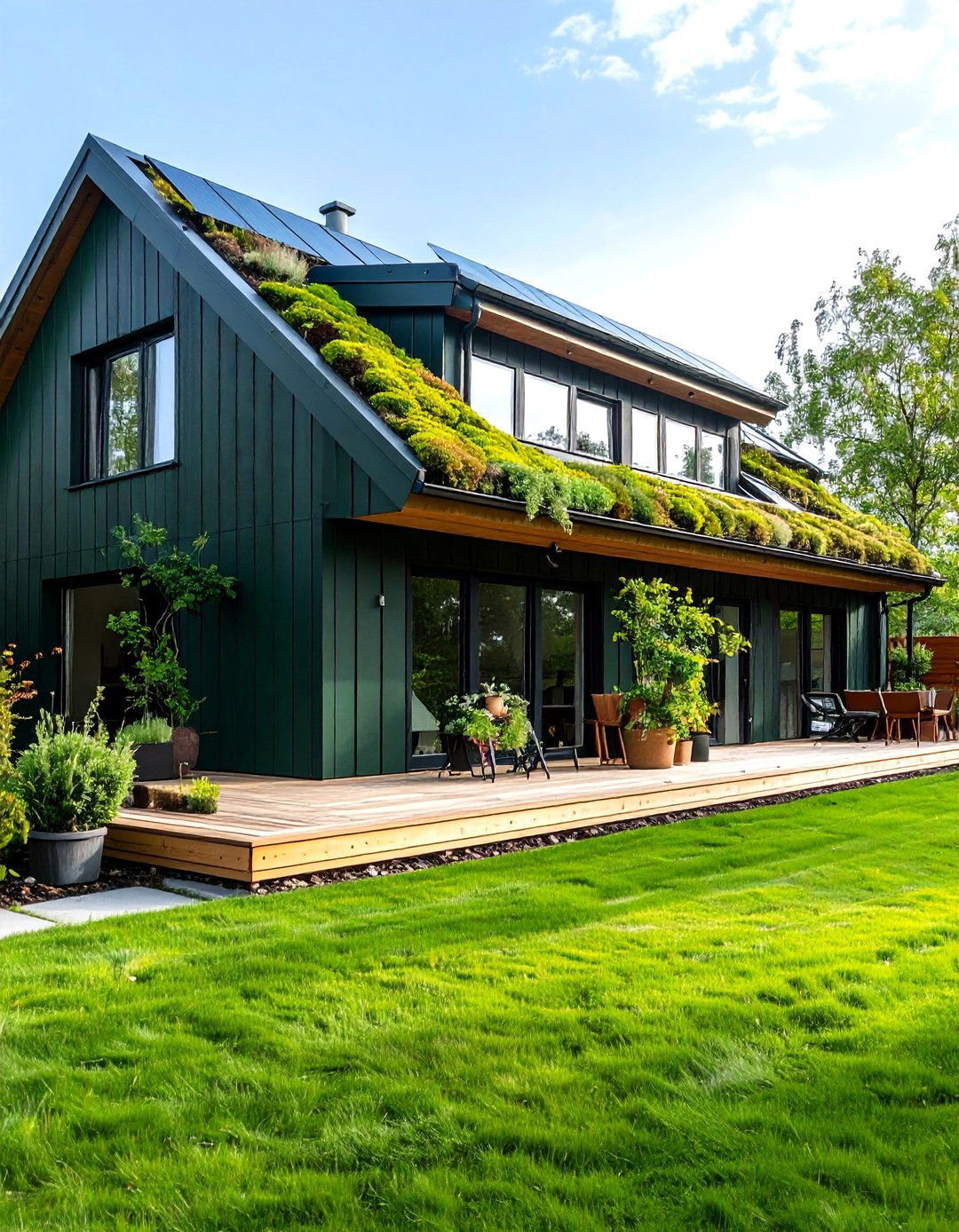
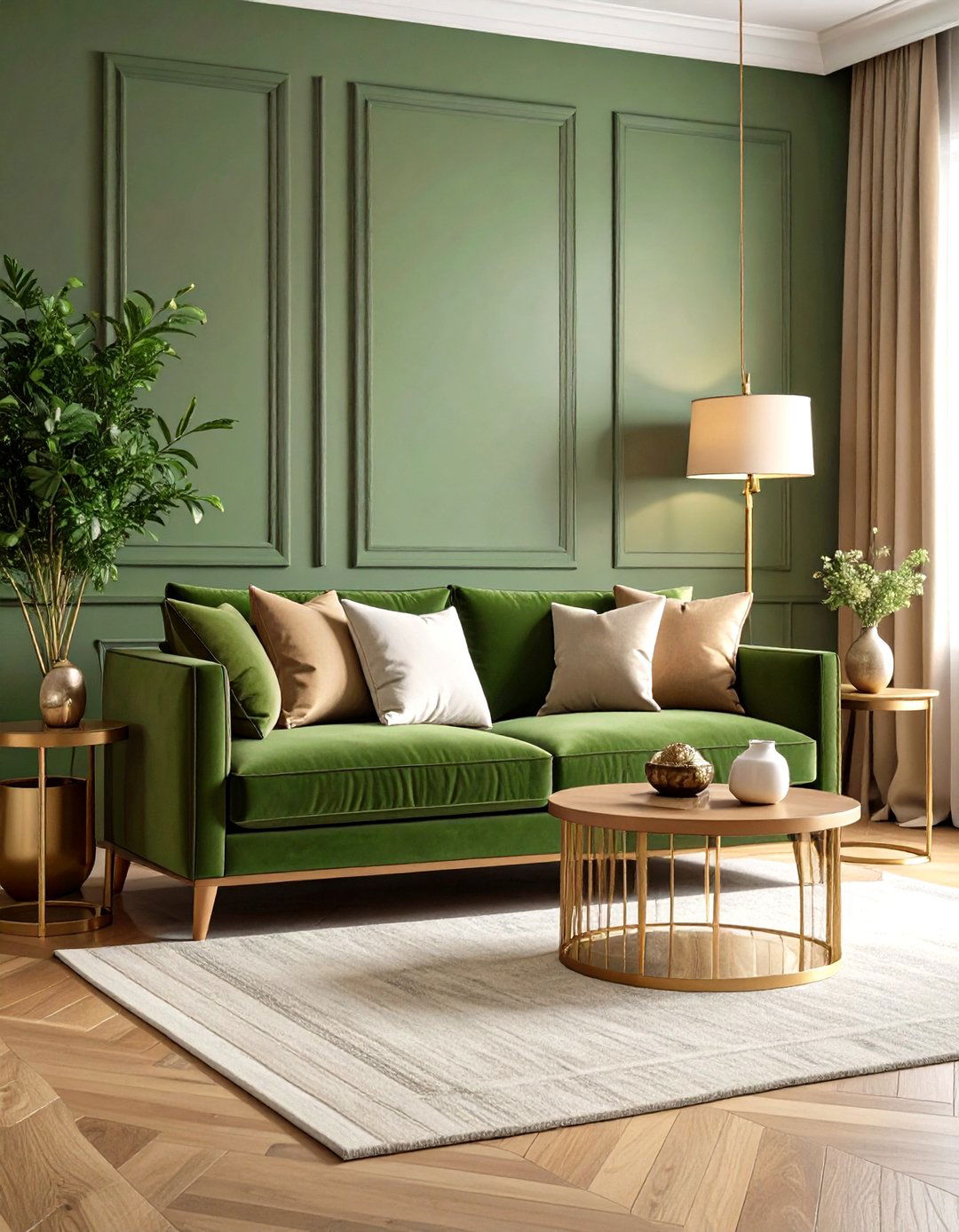
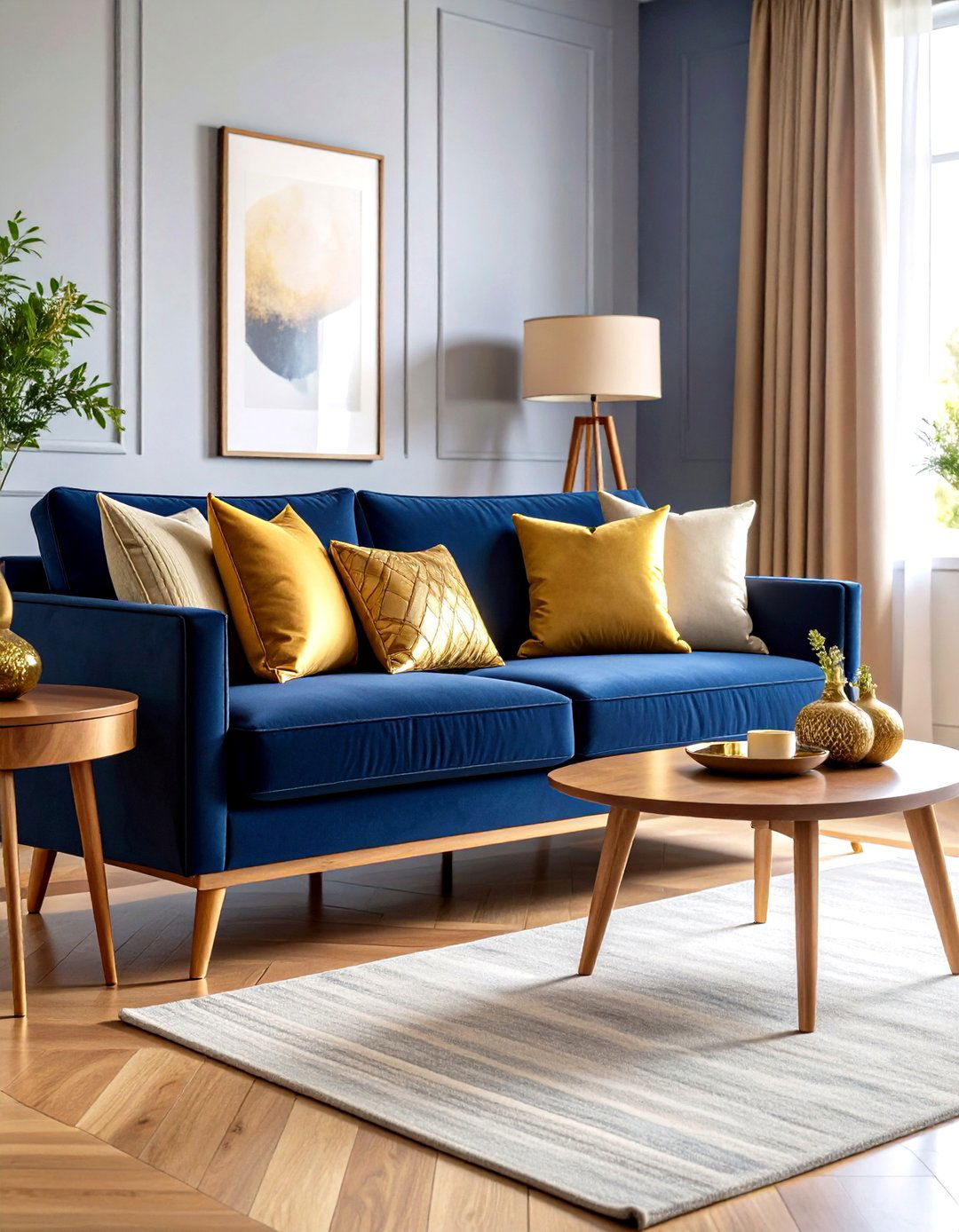
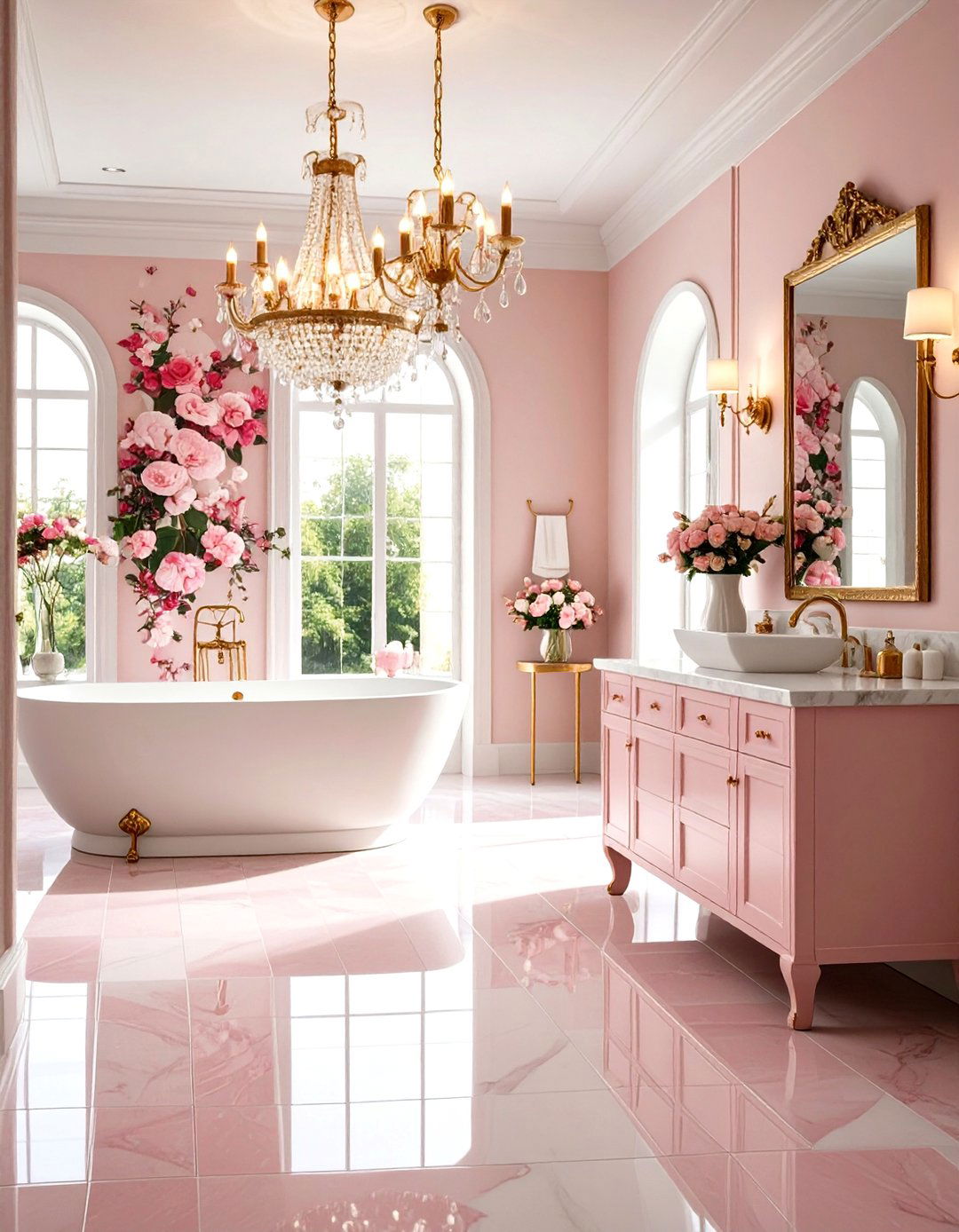
Leave a Reply